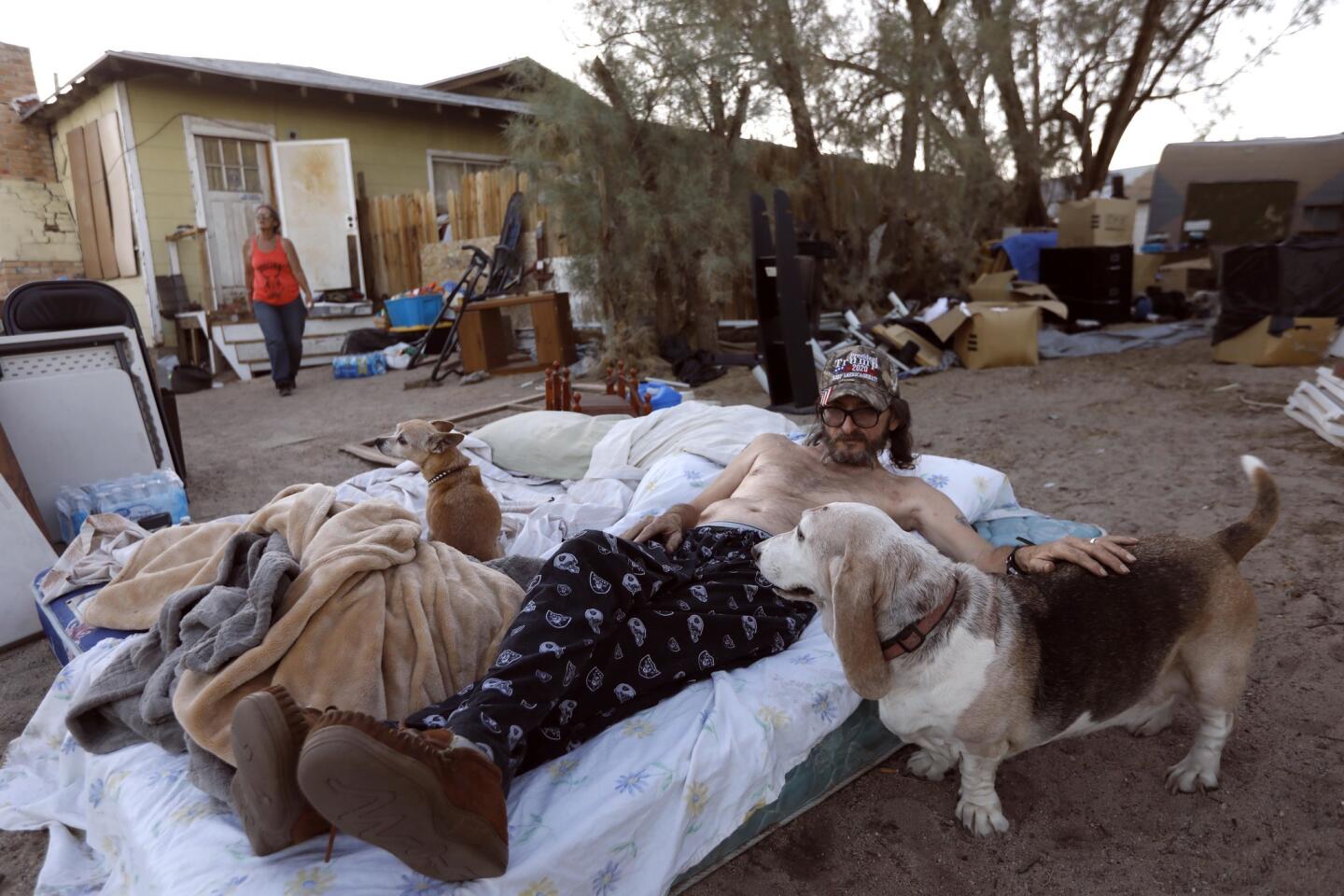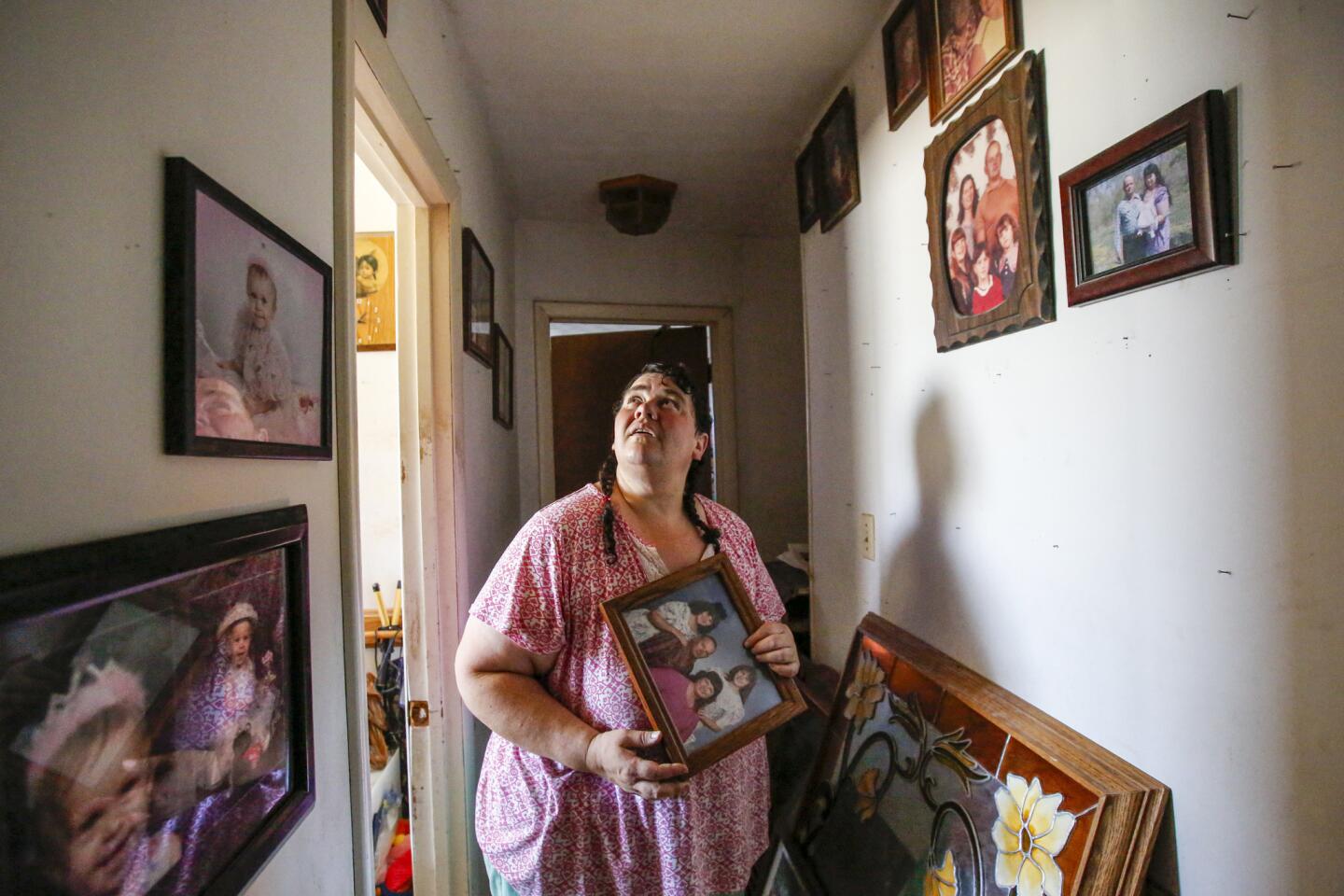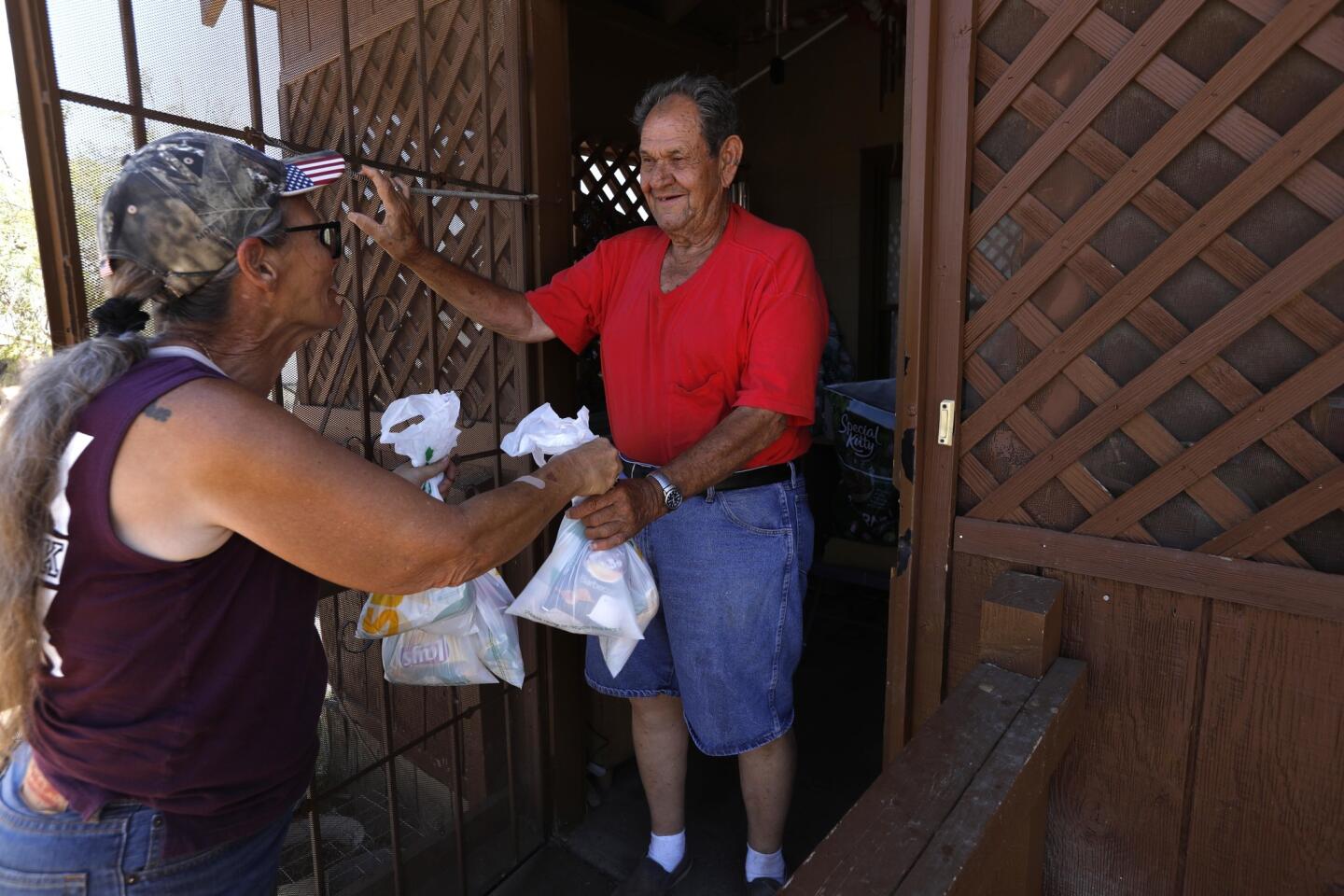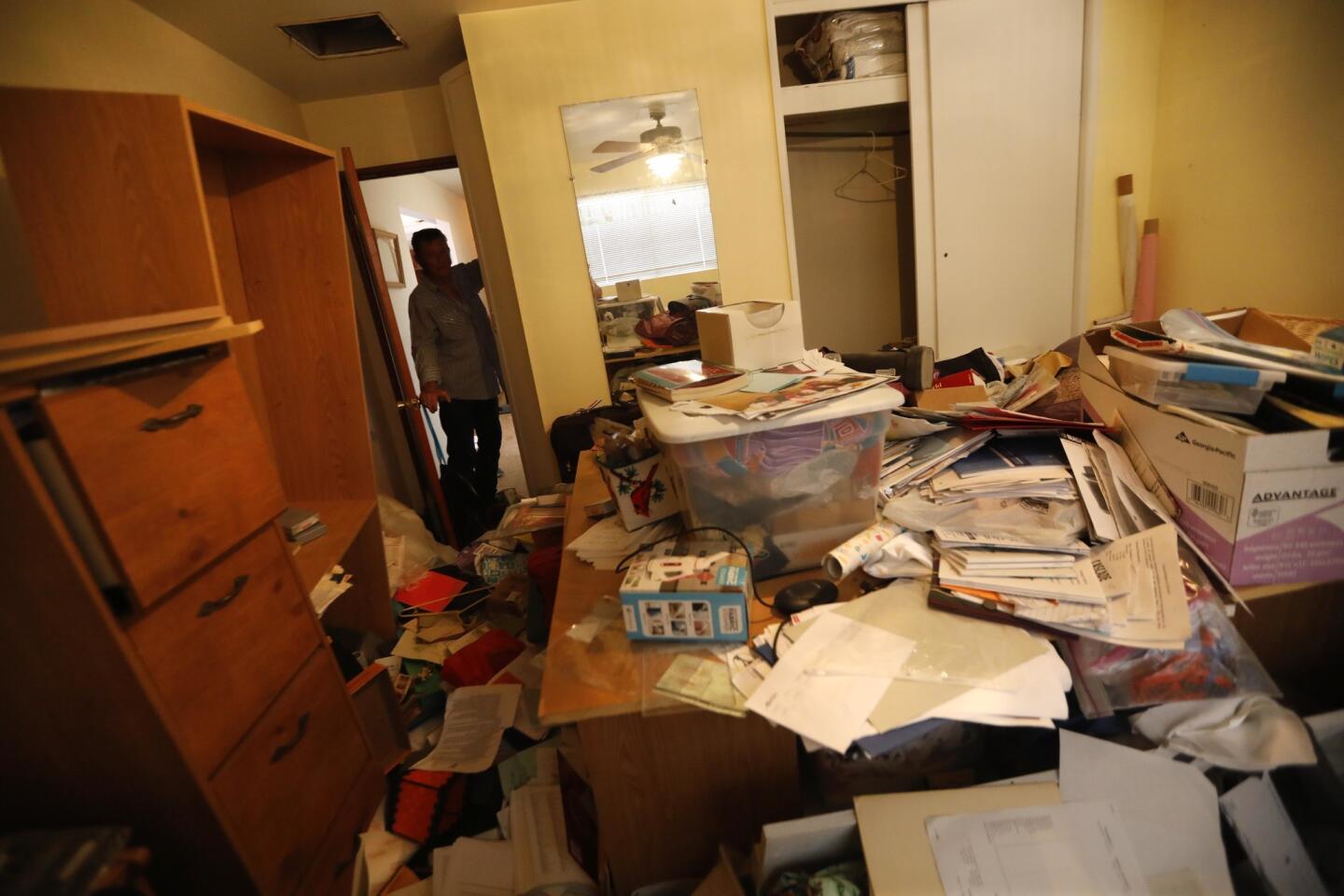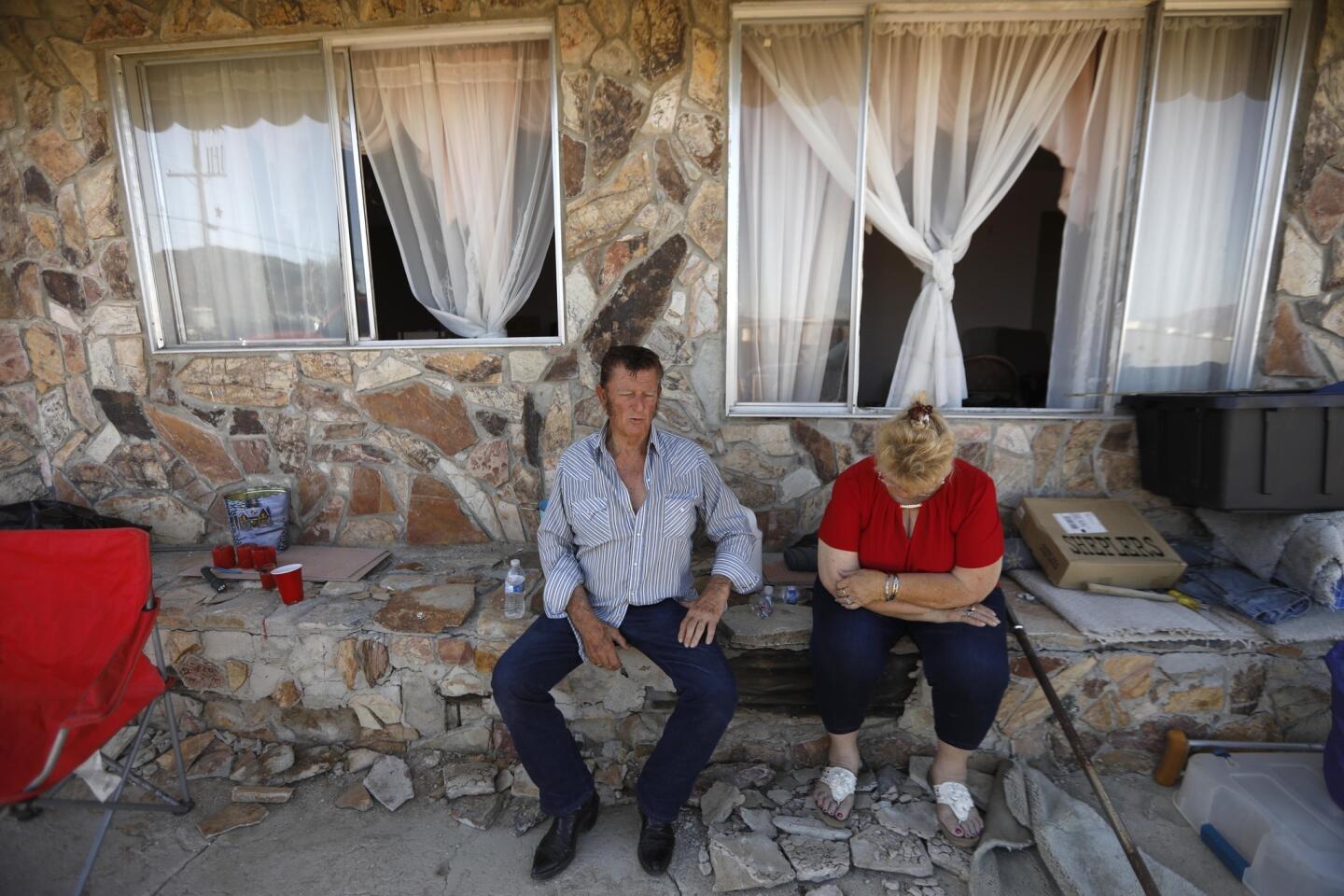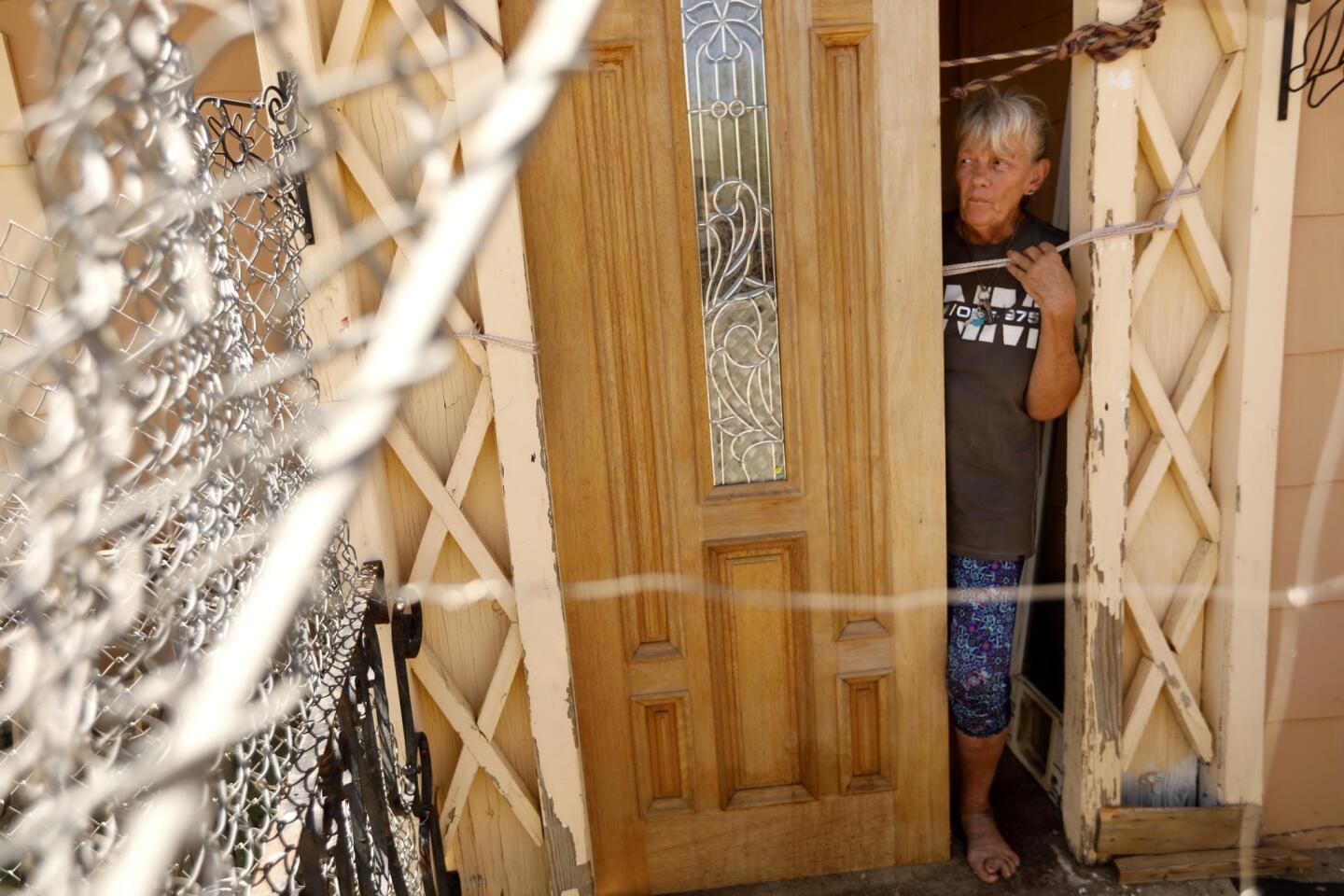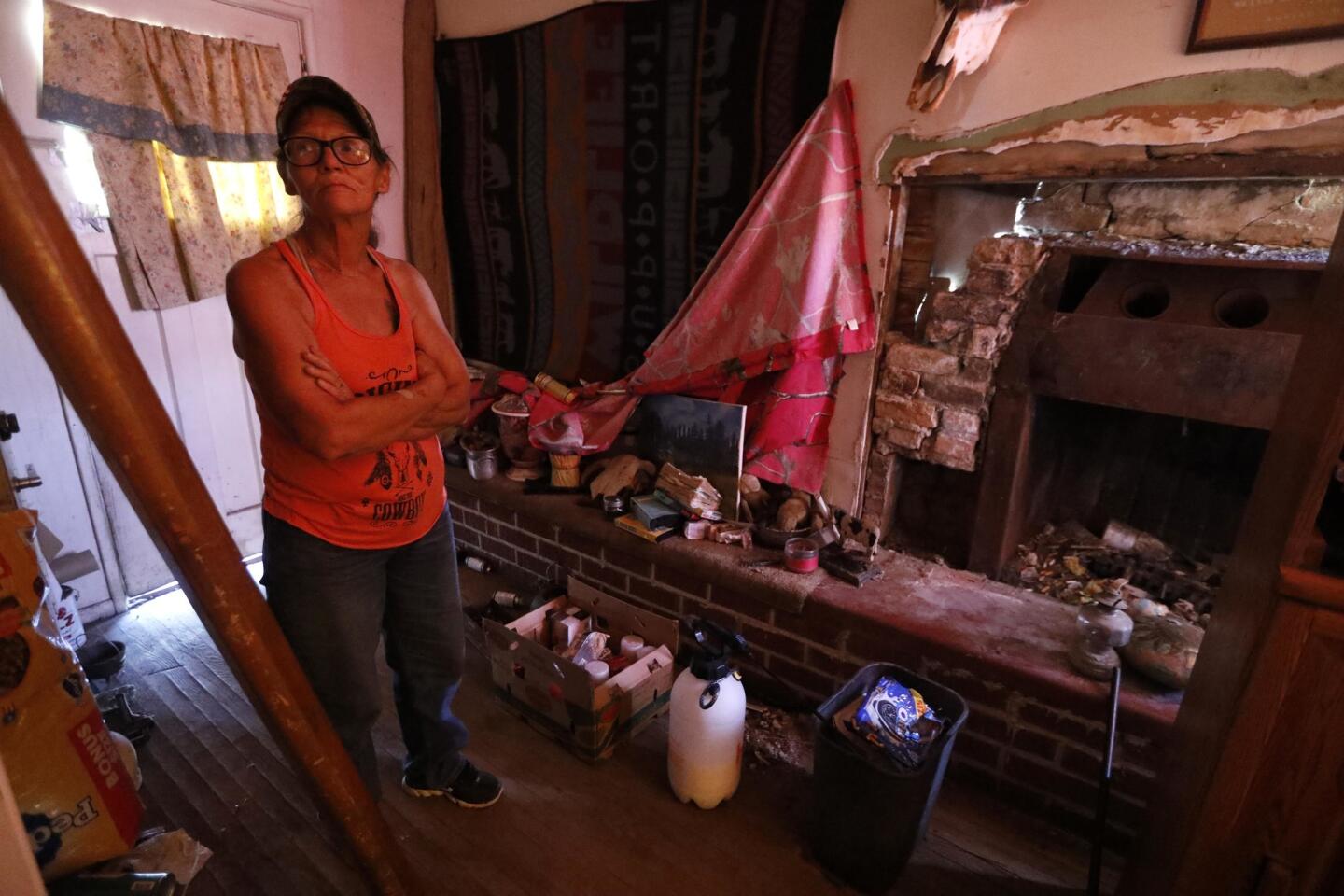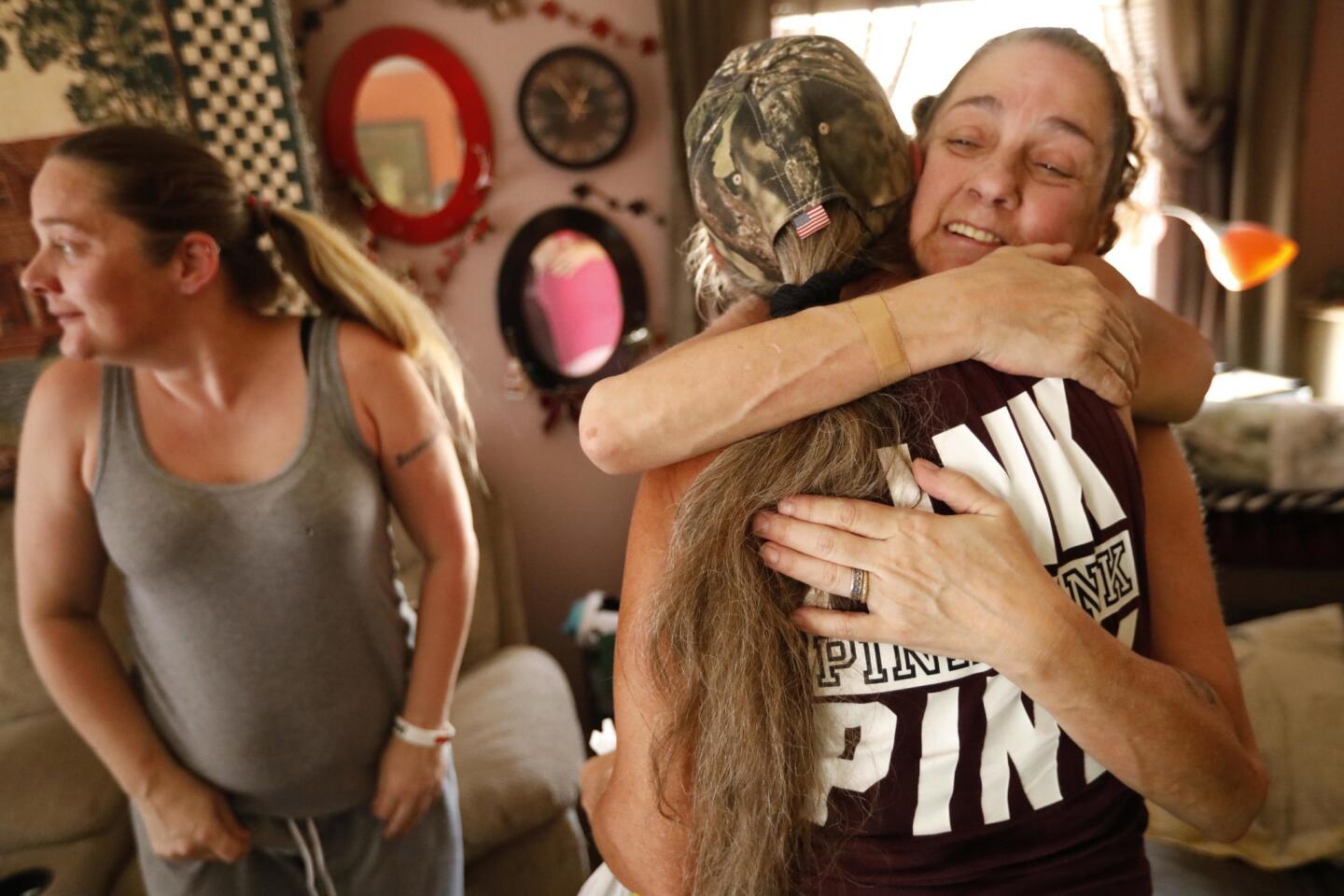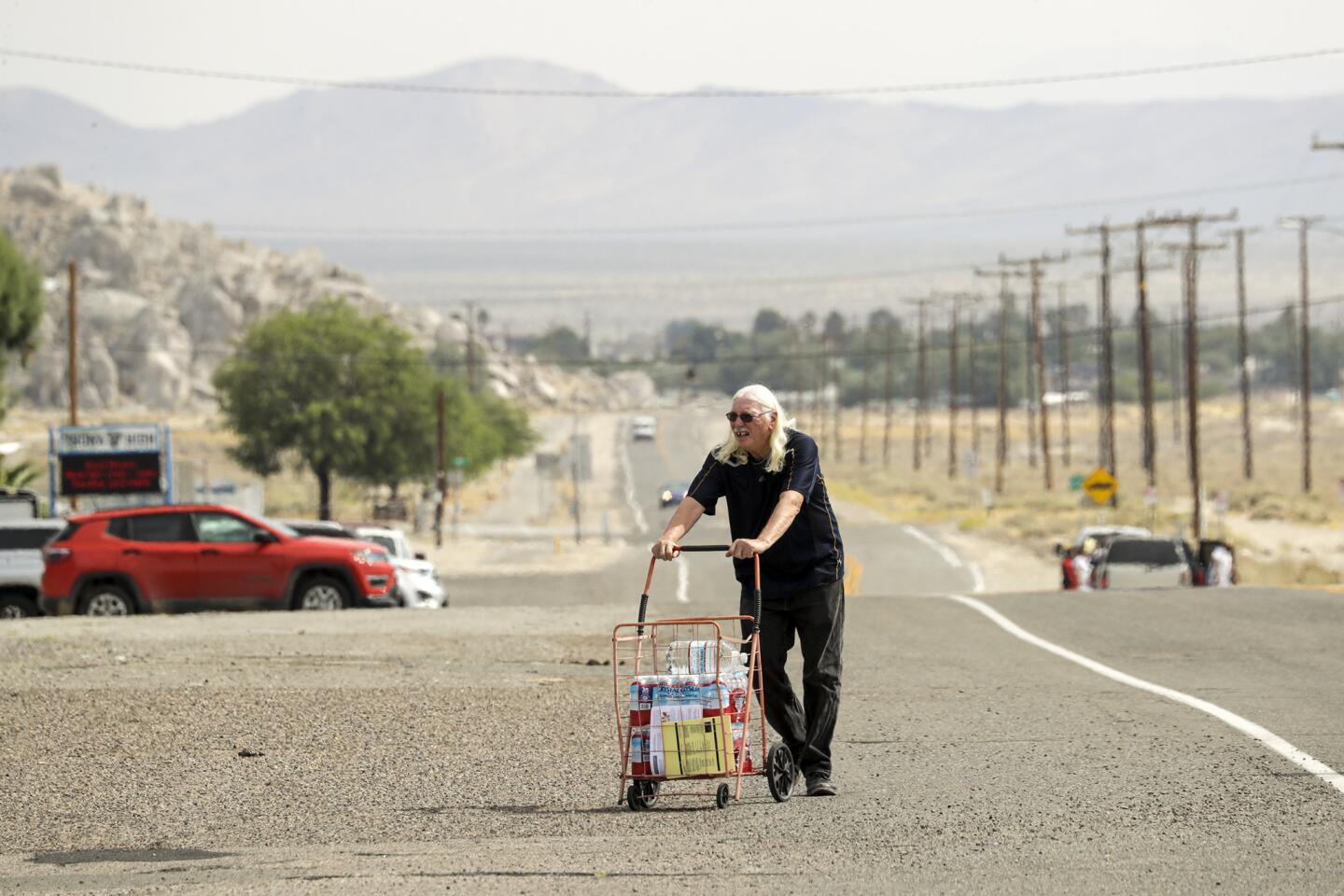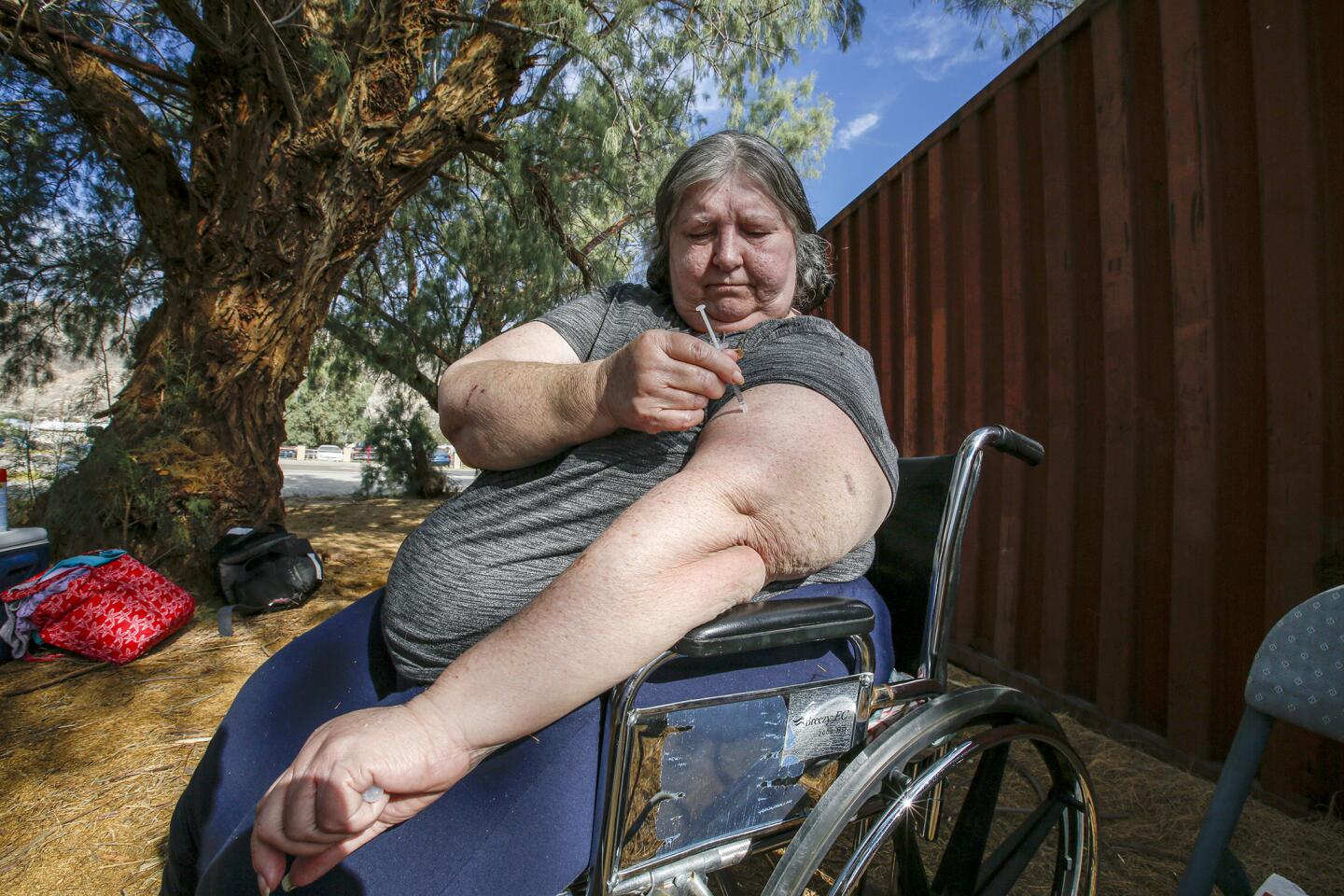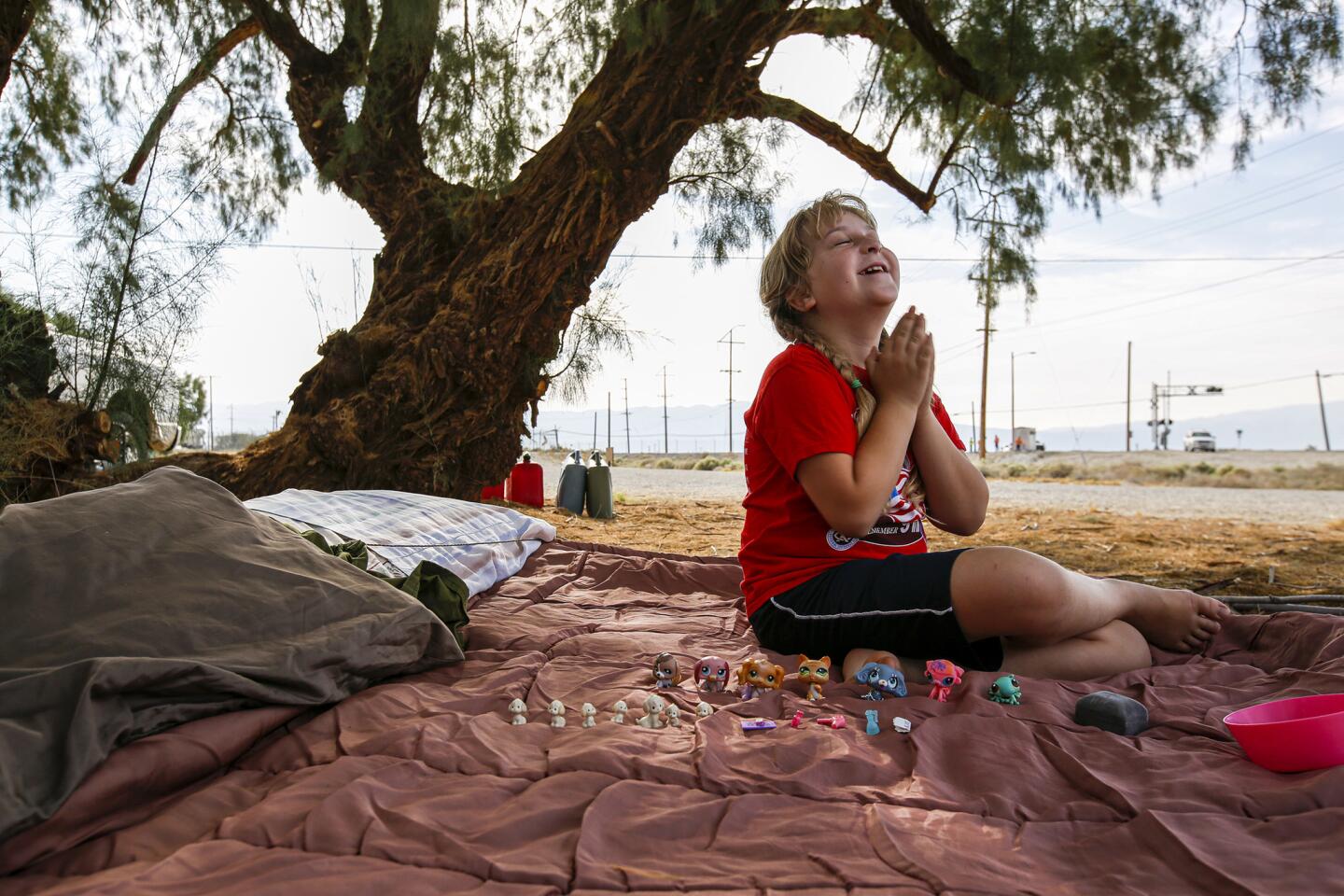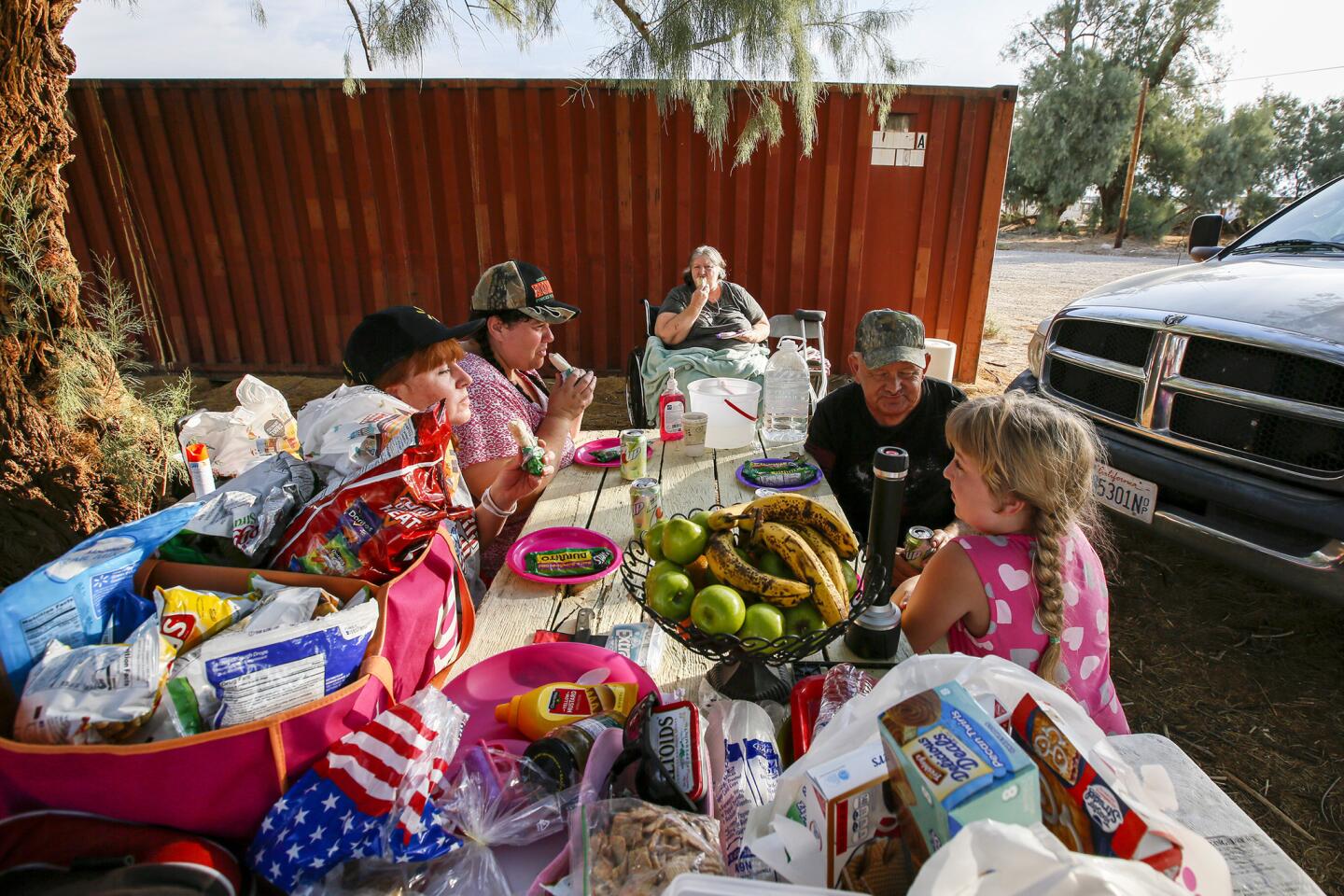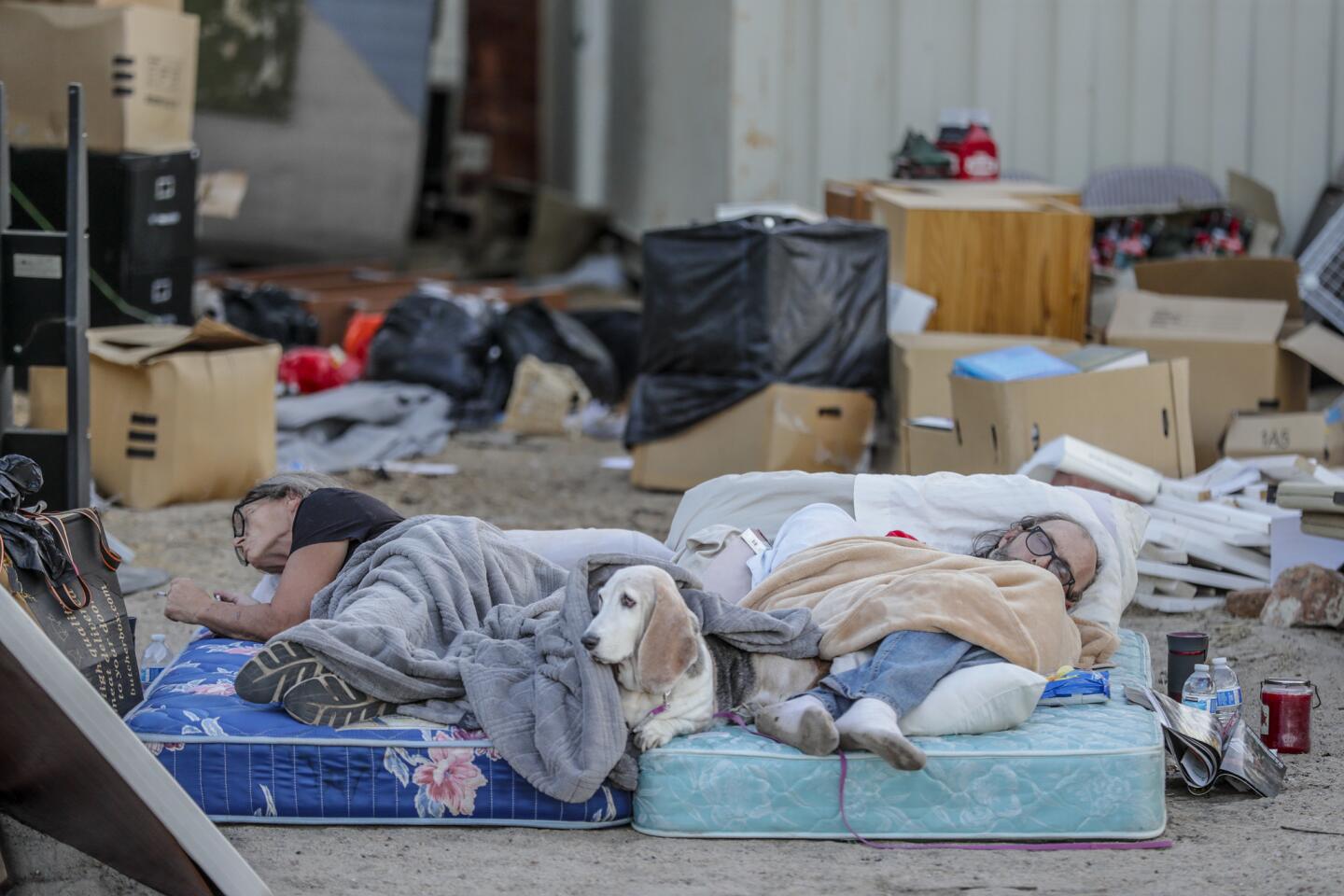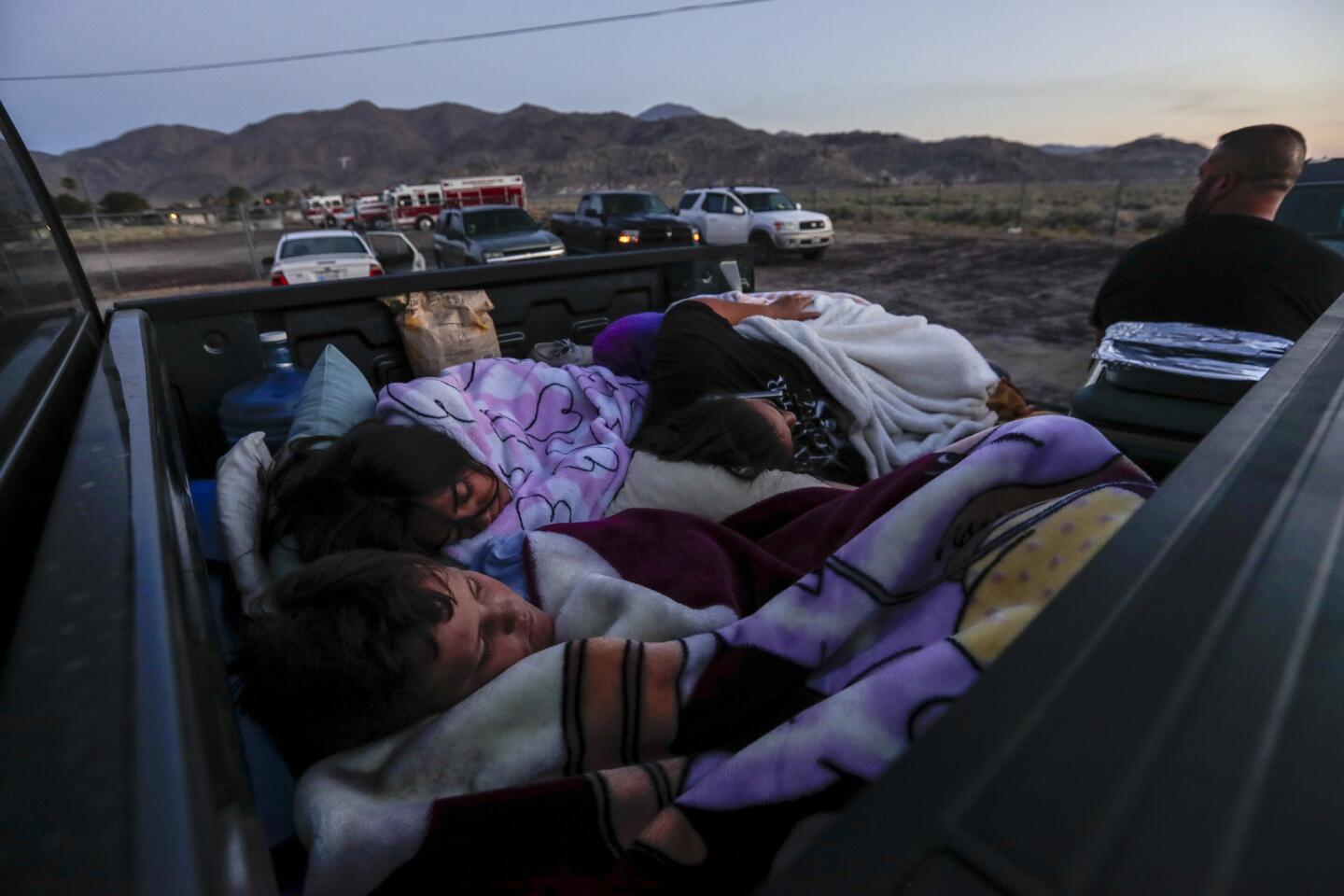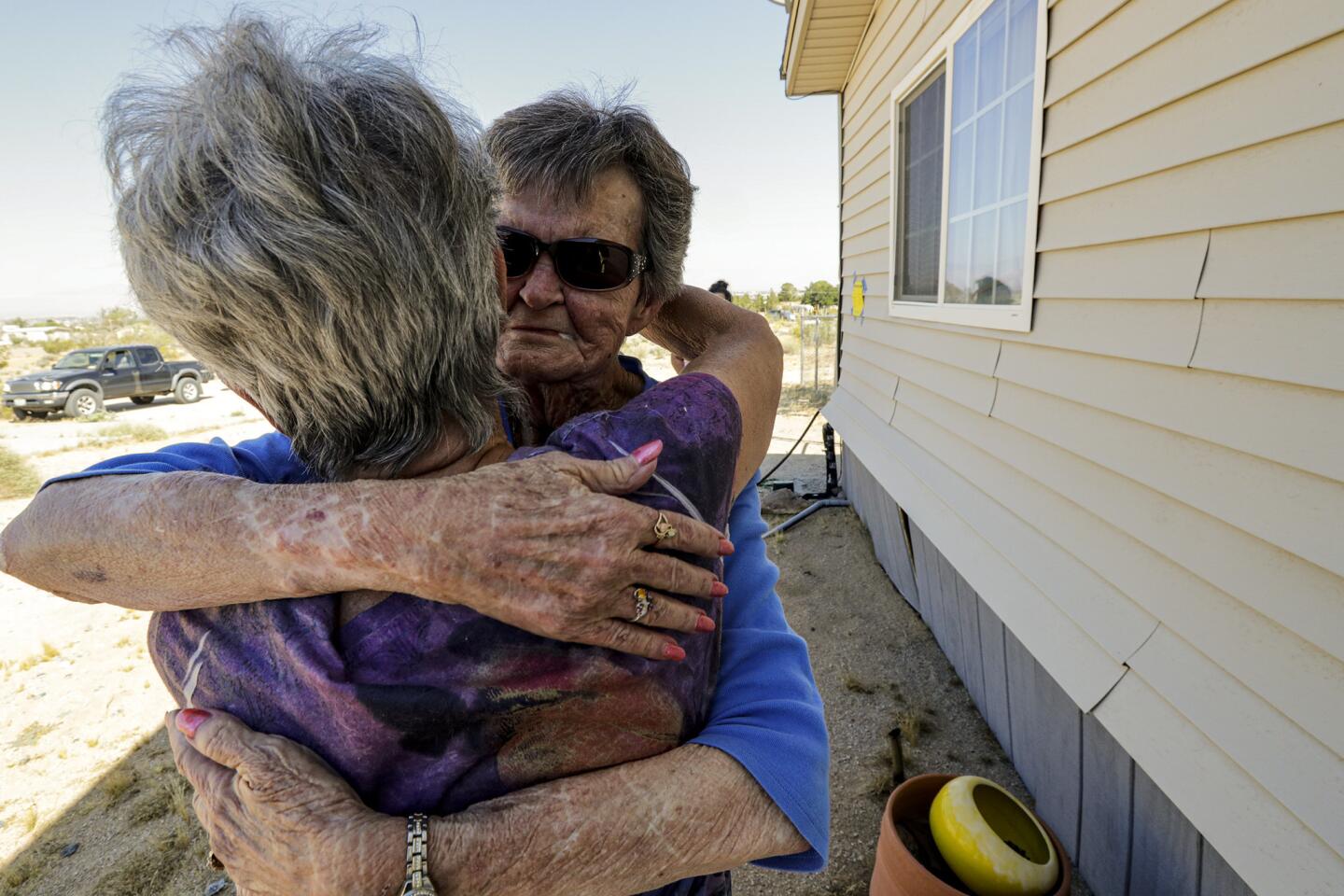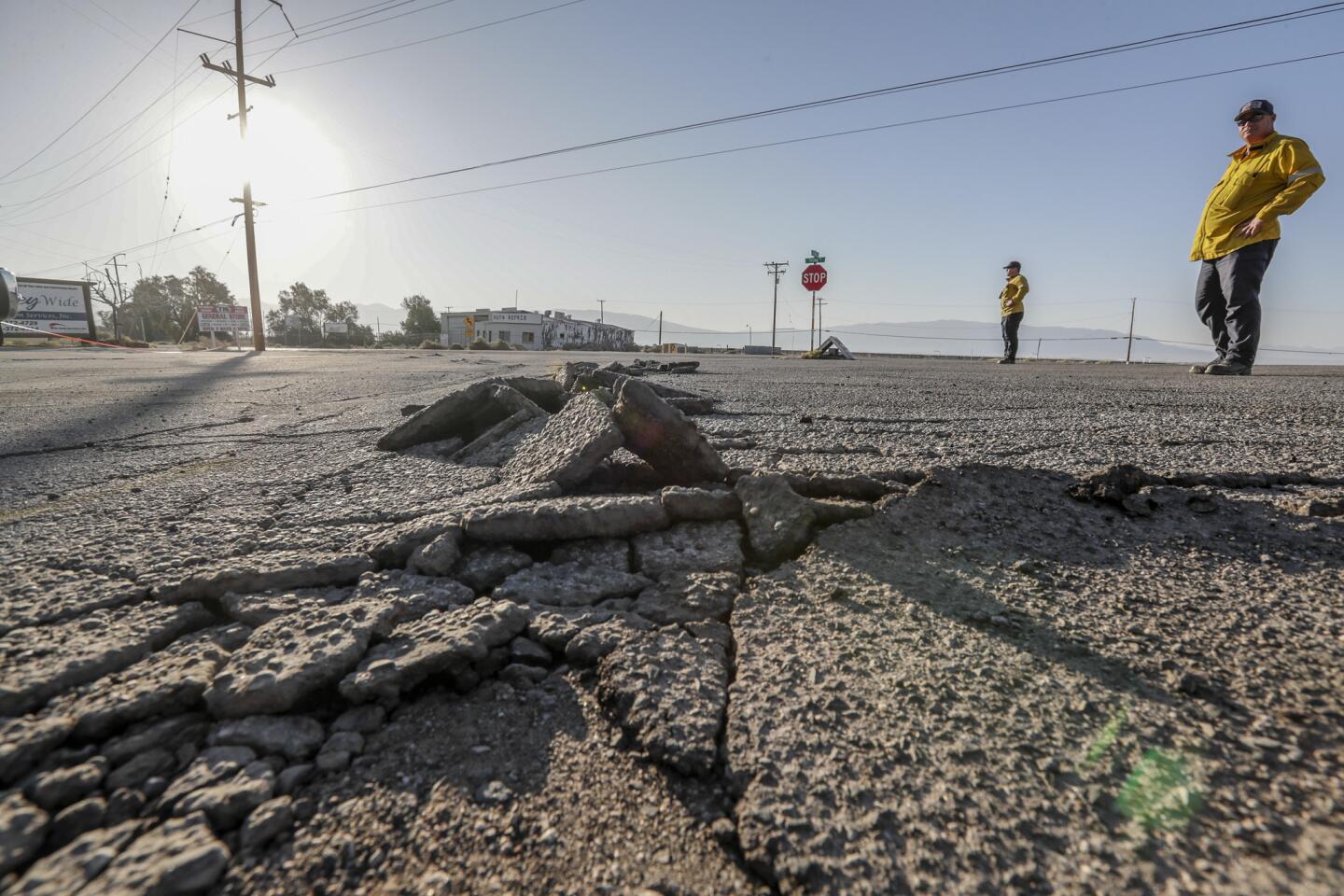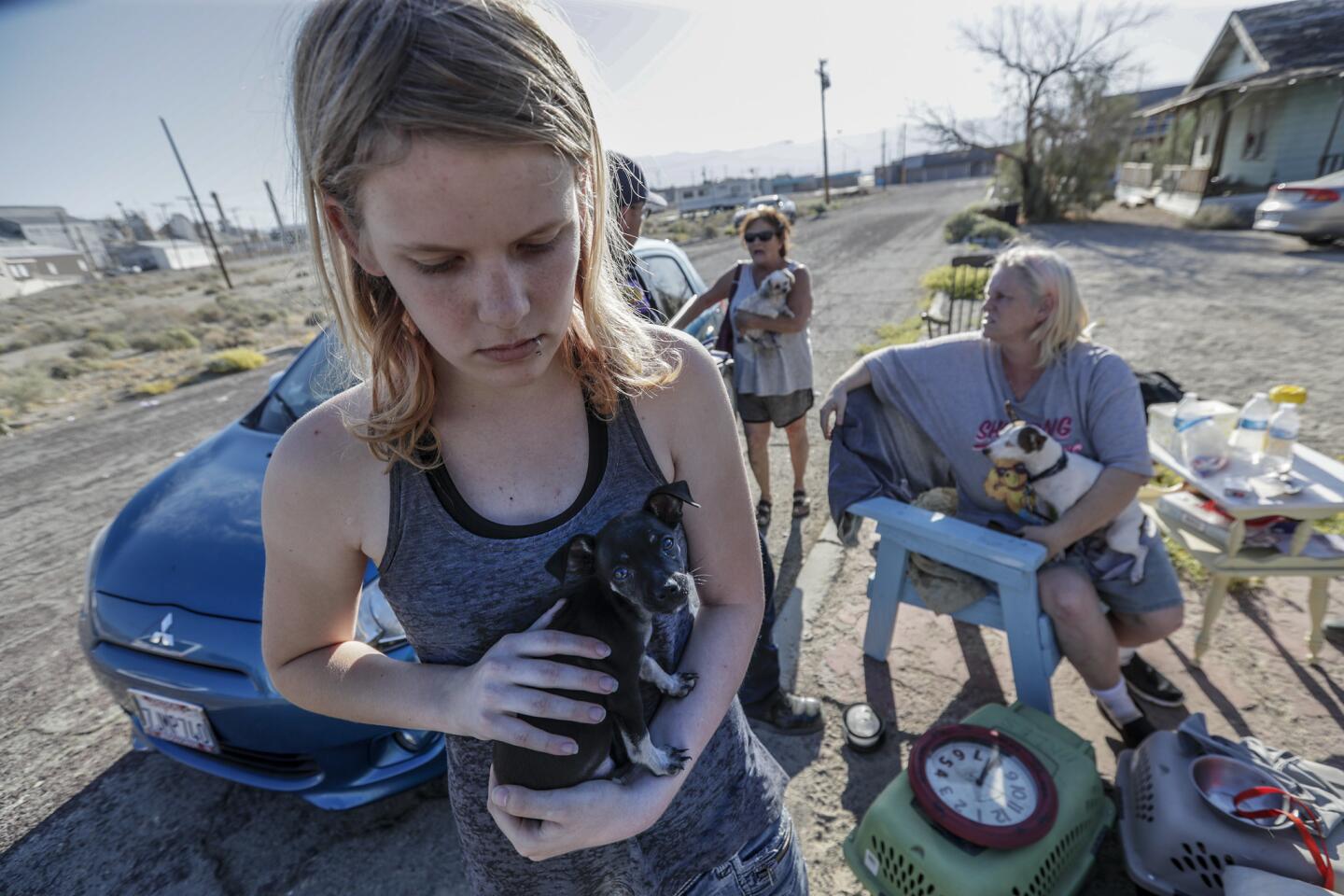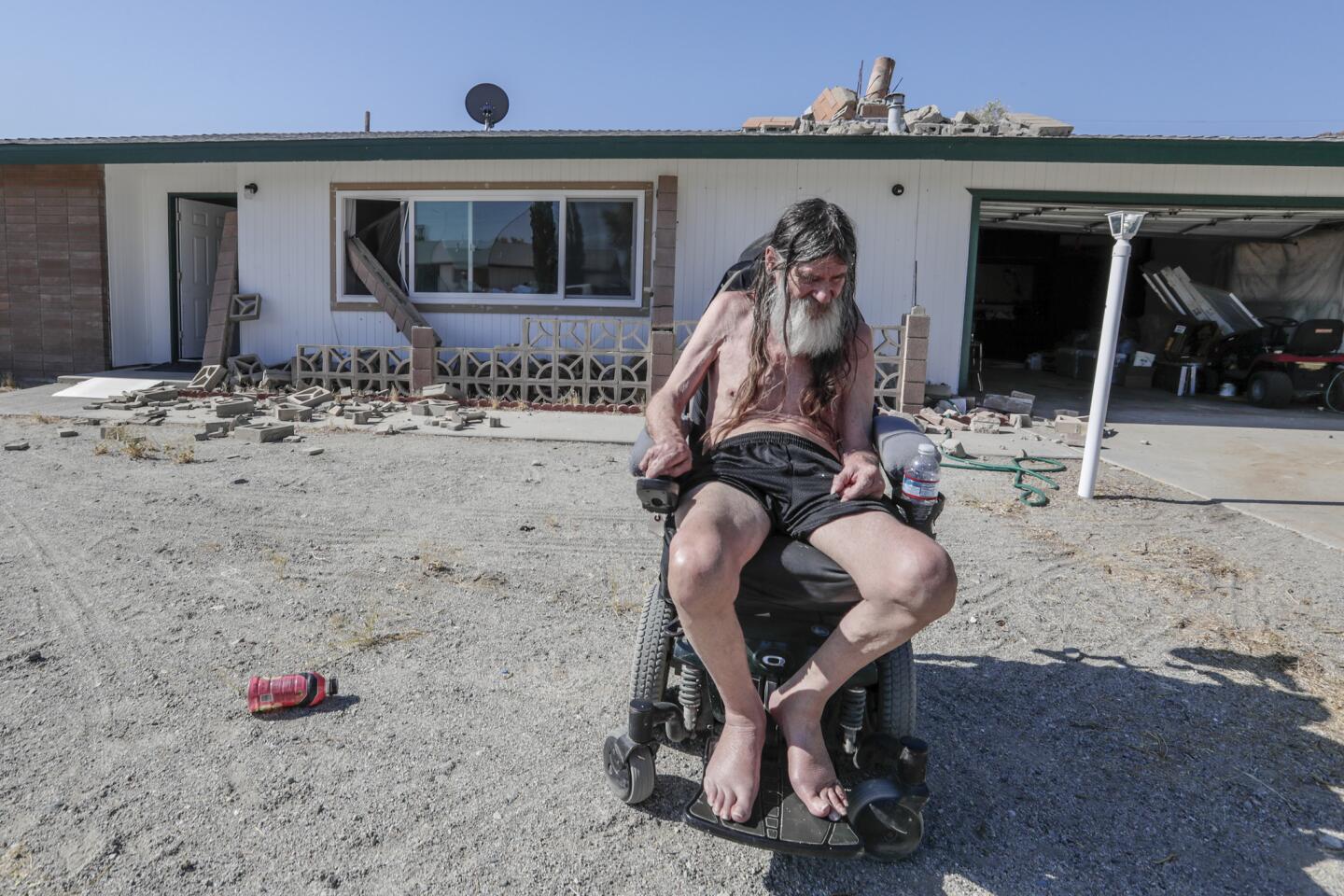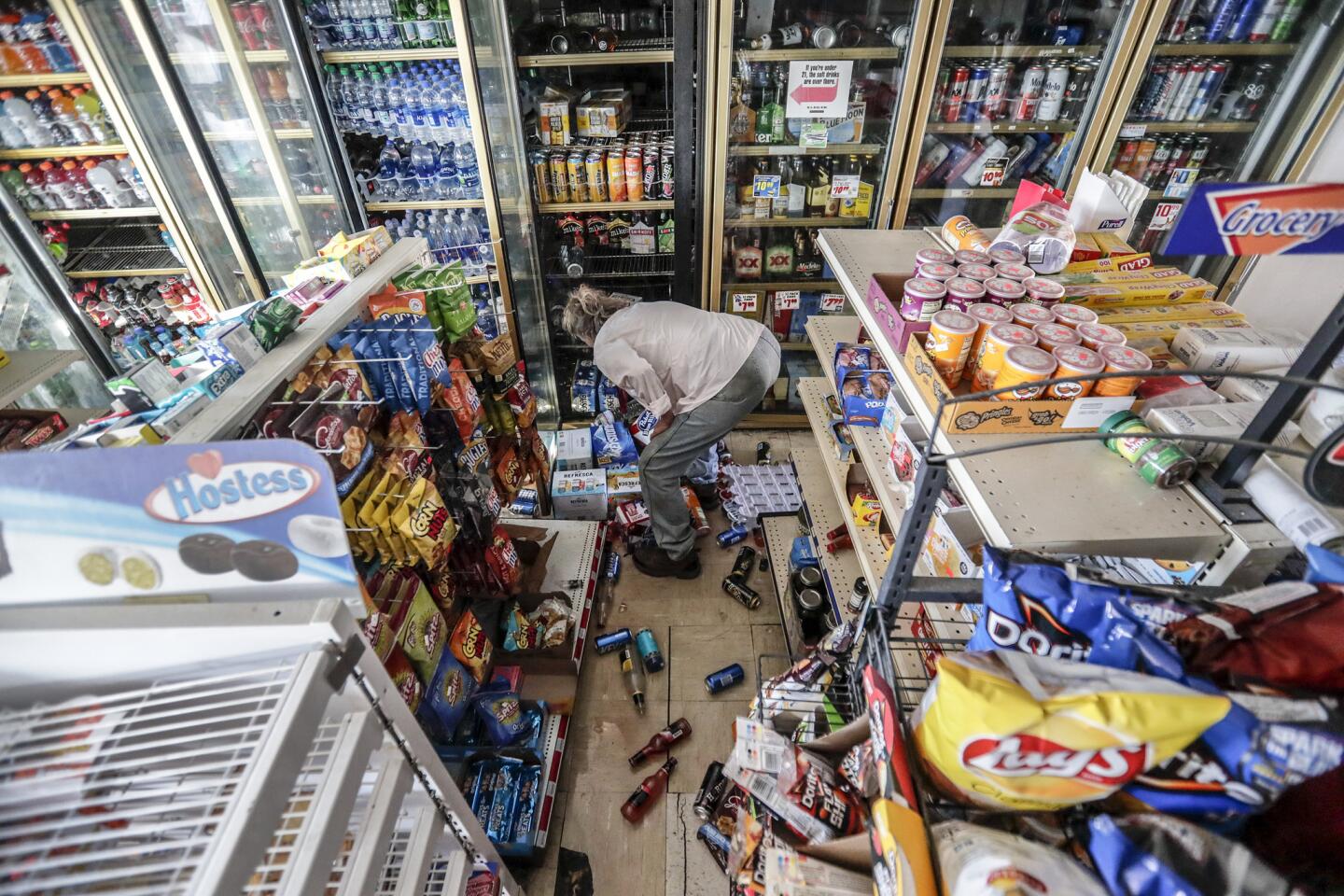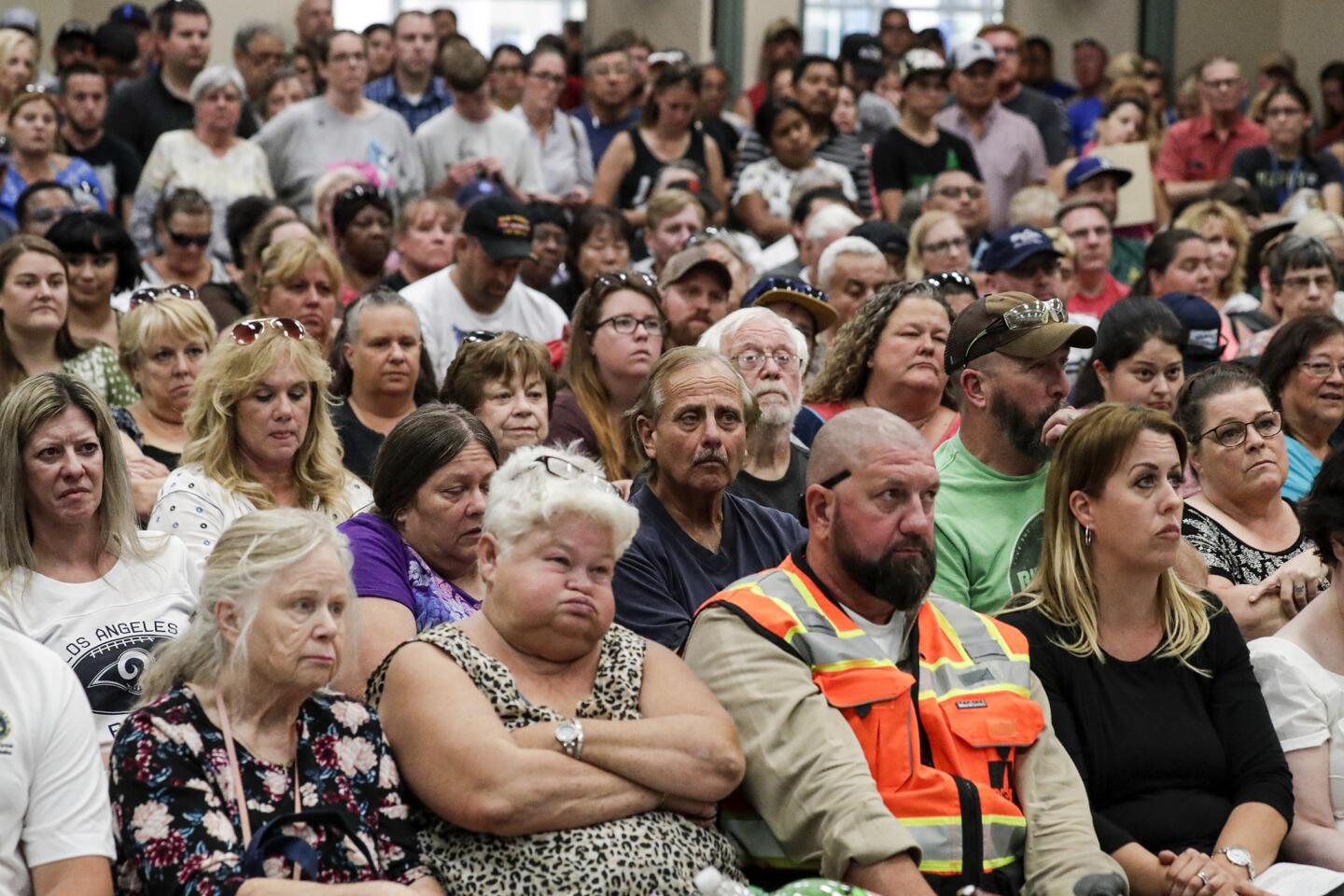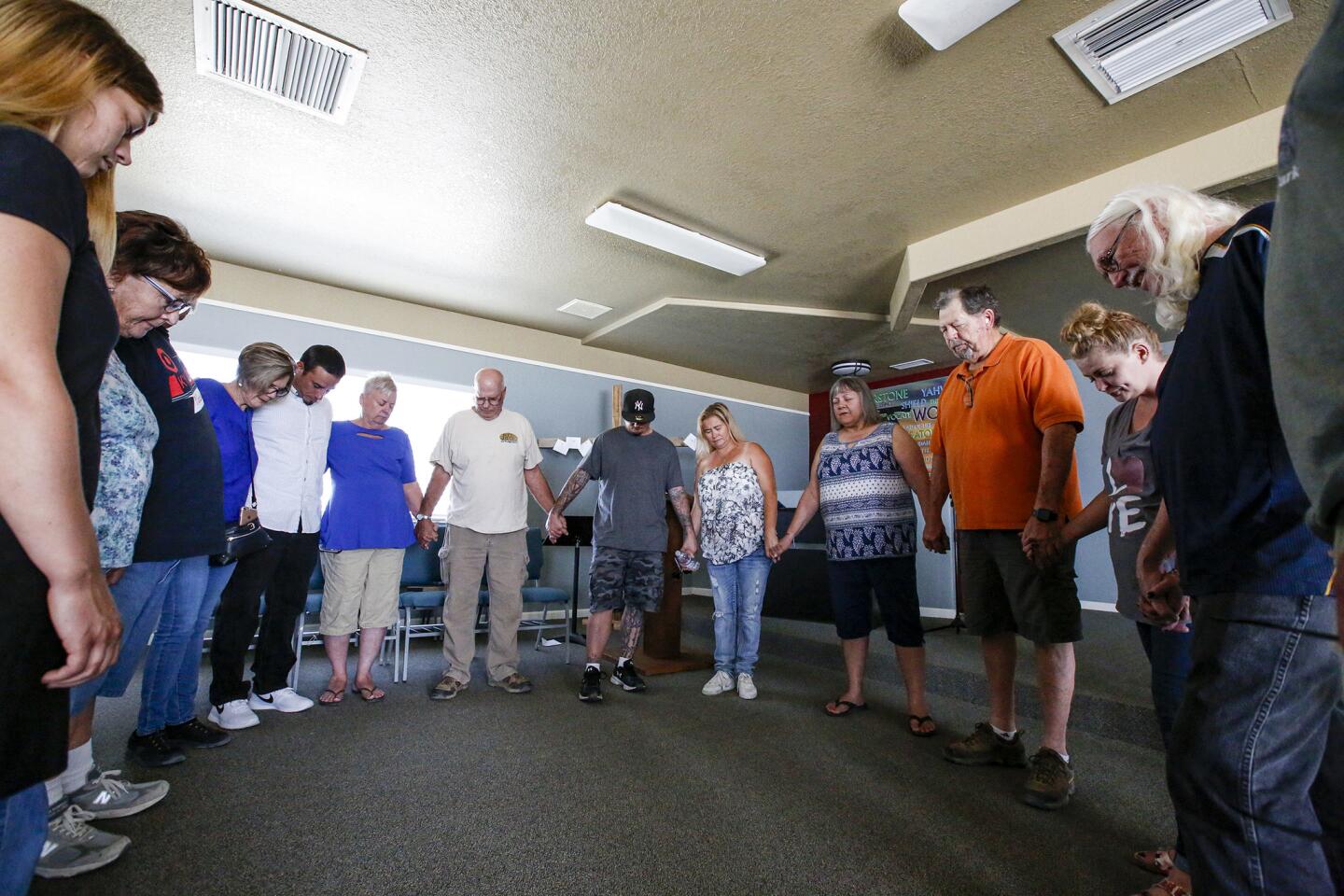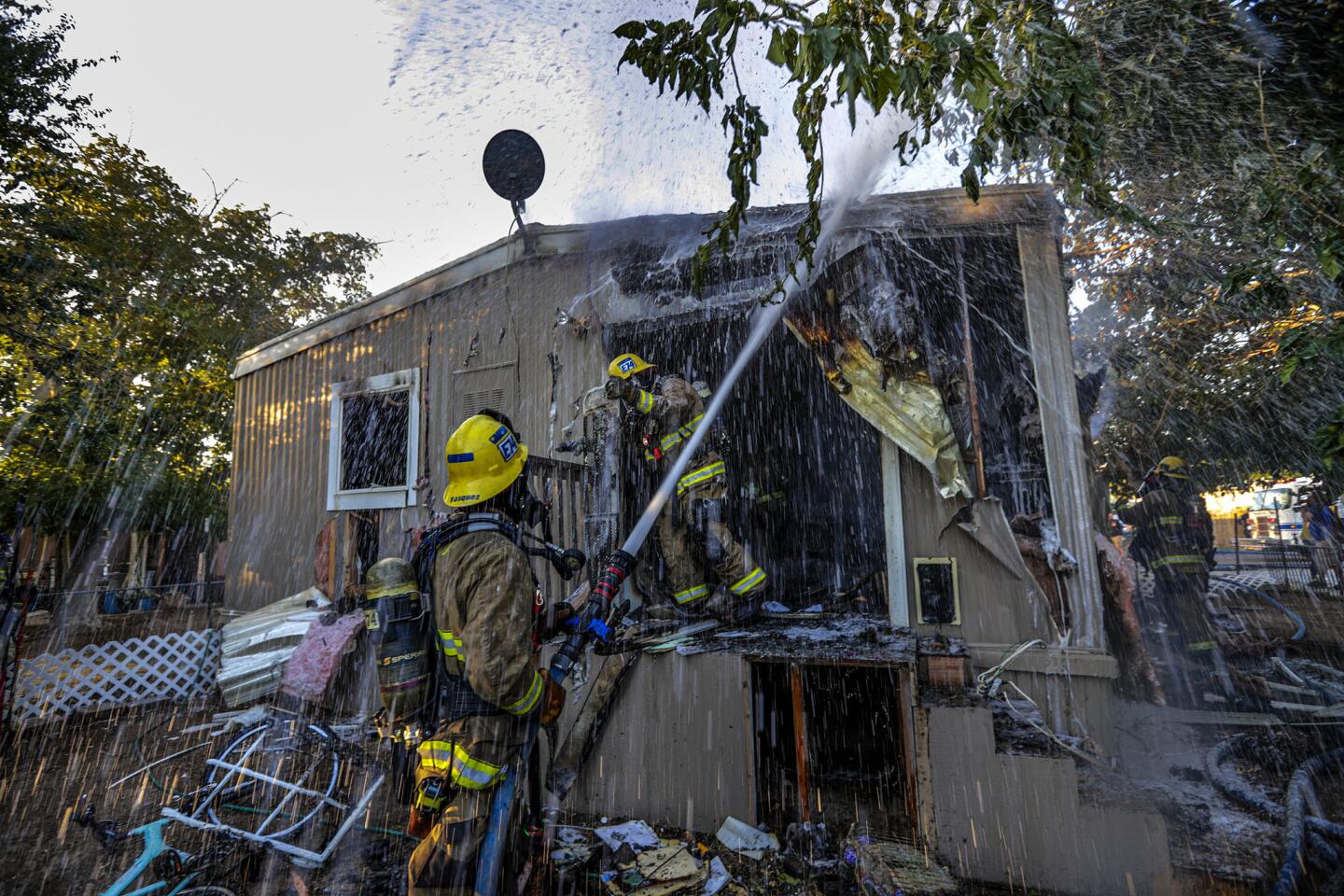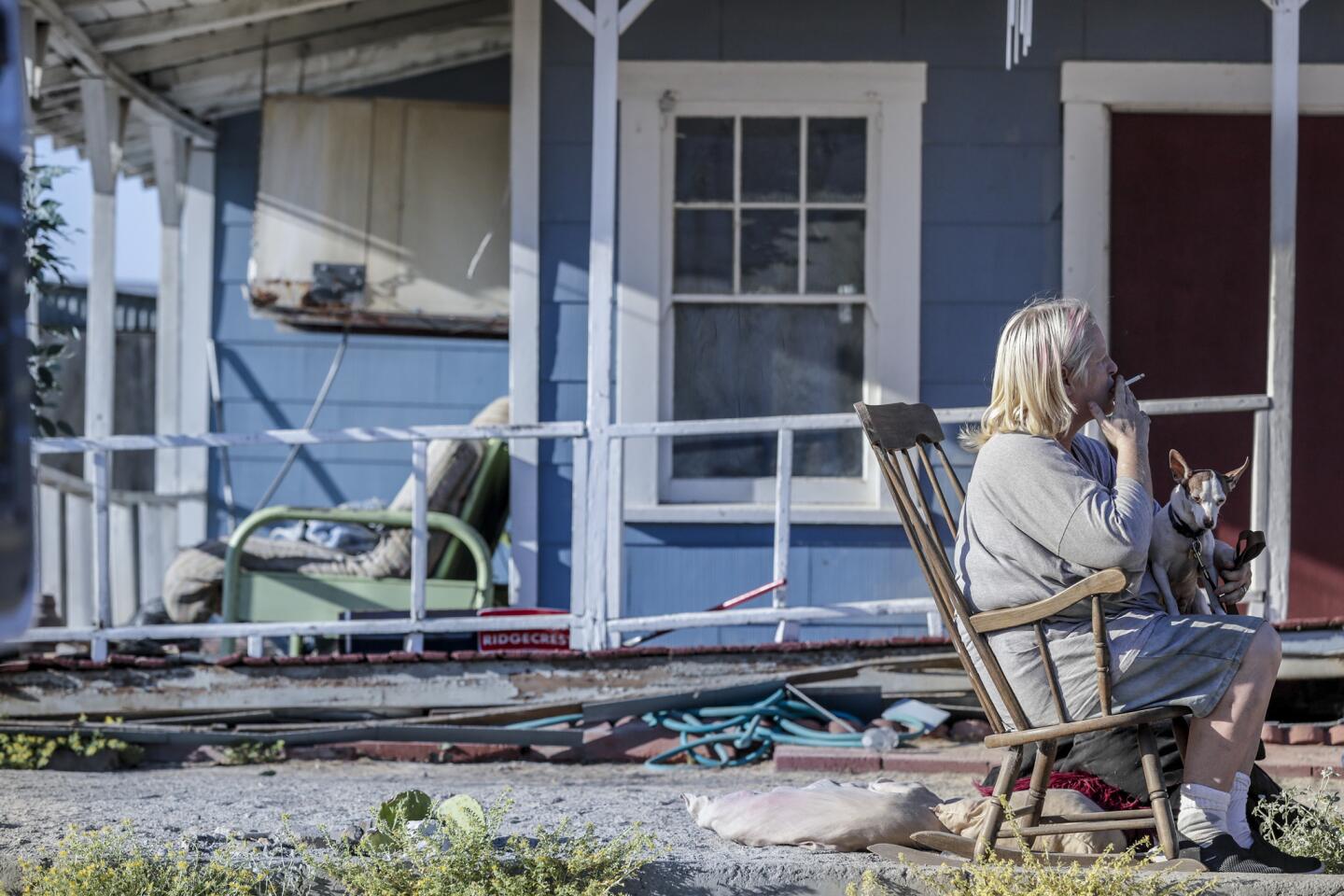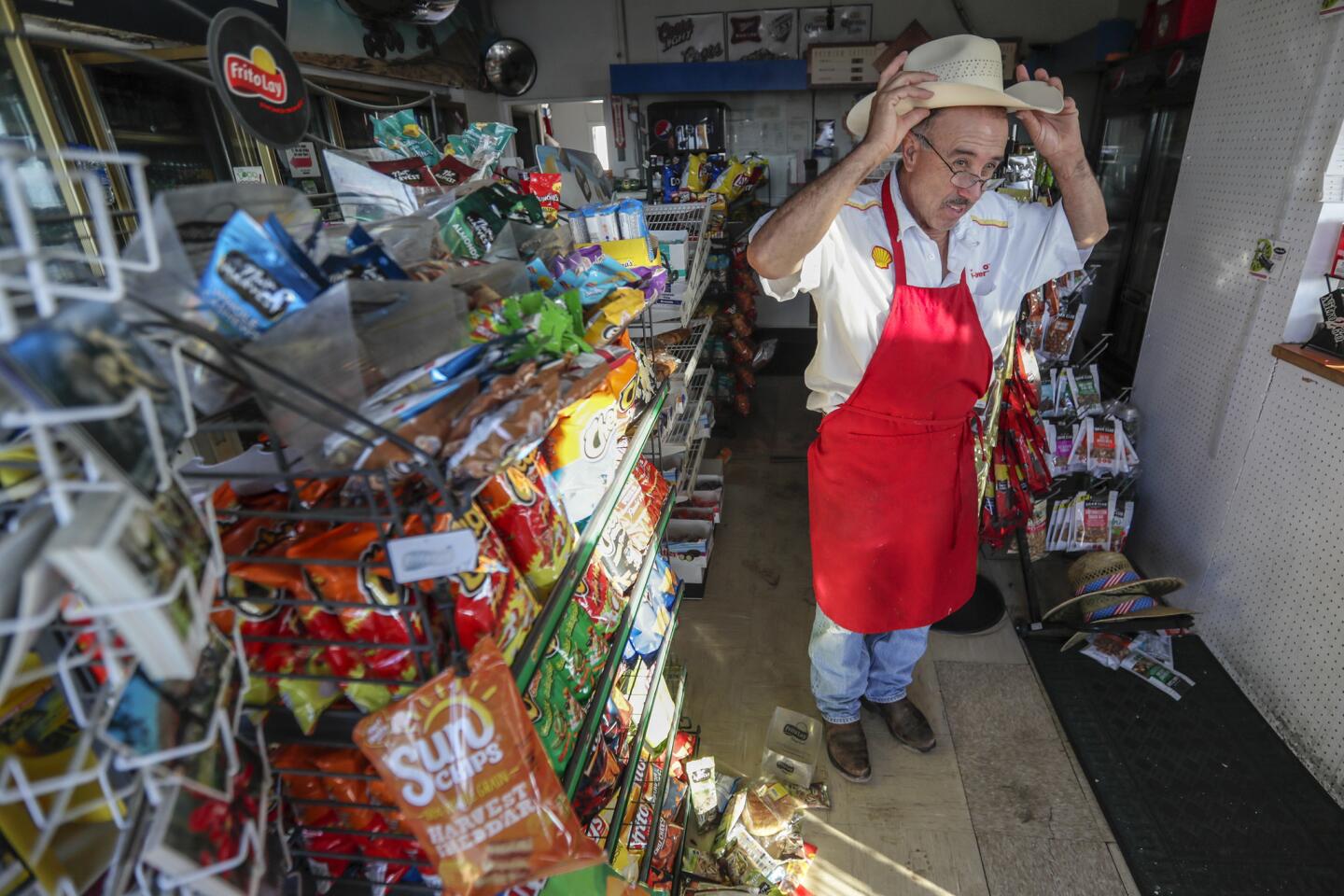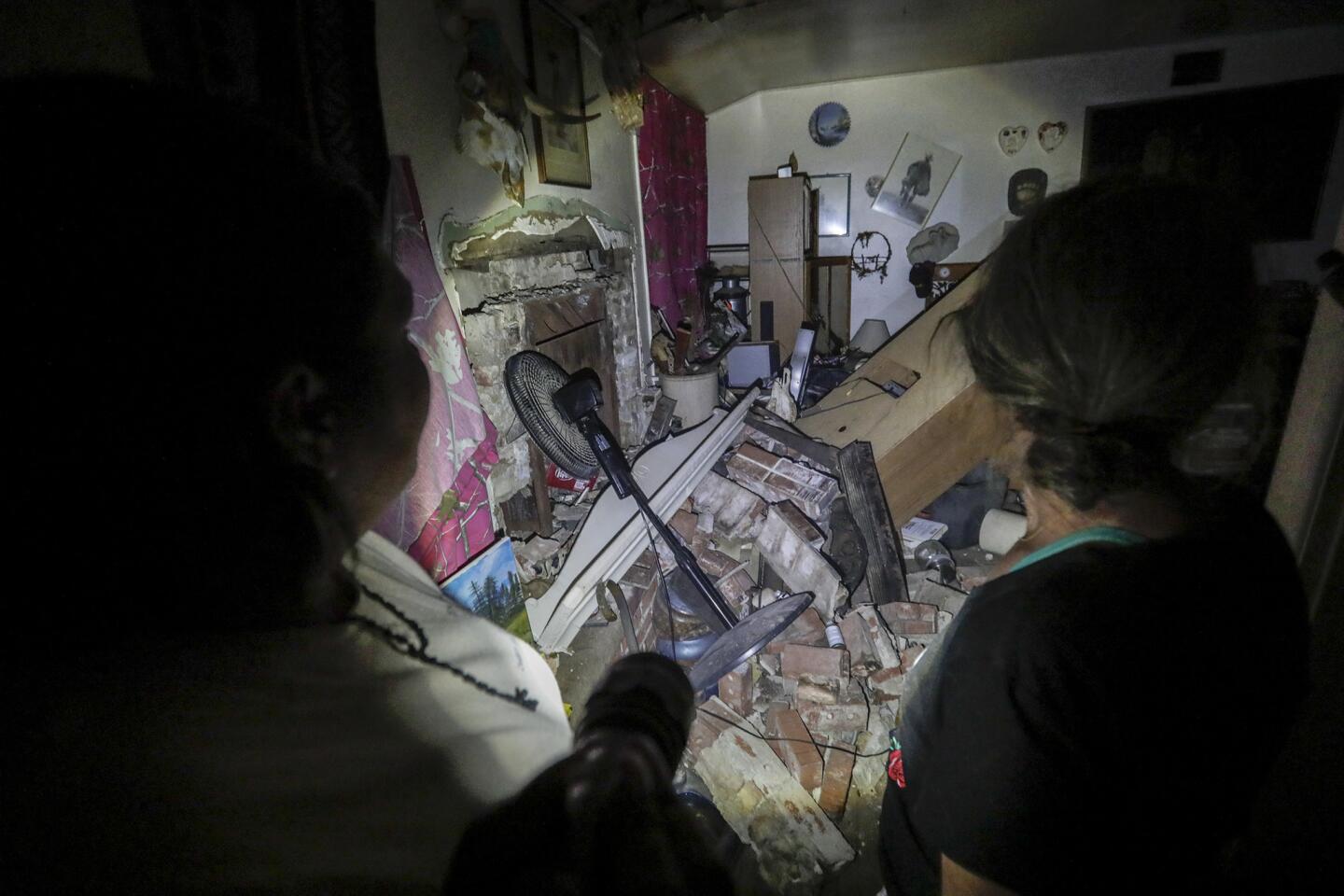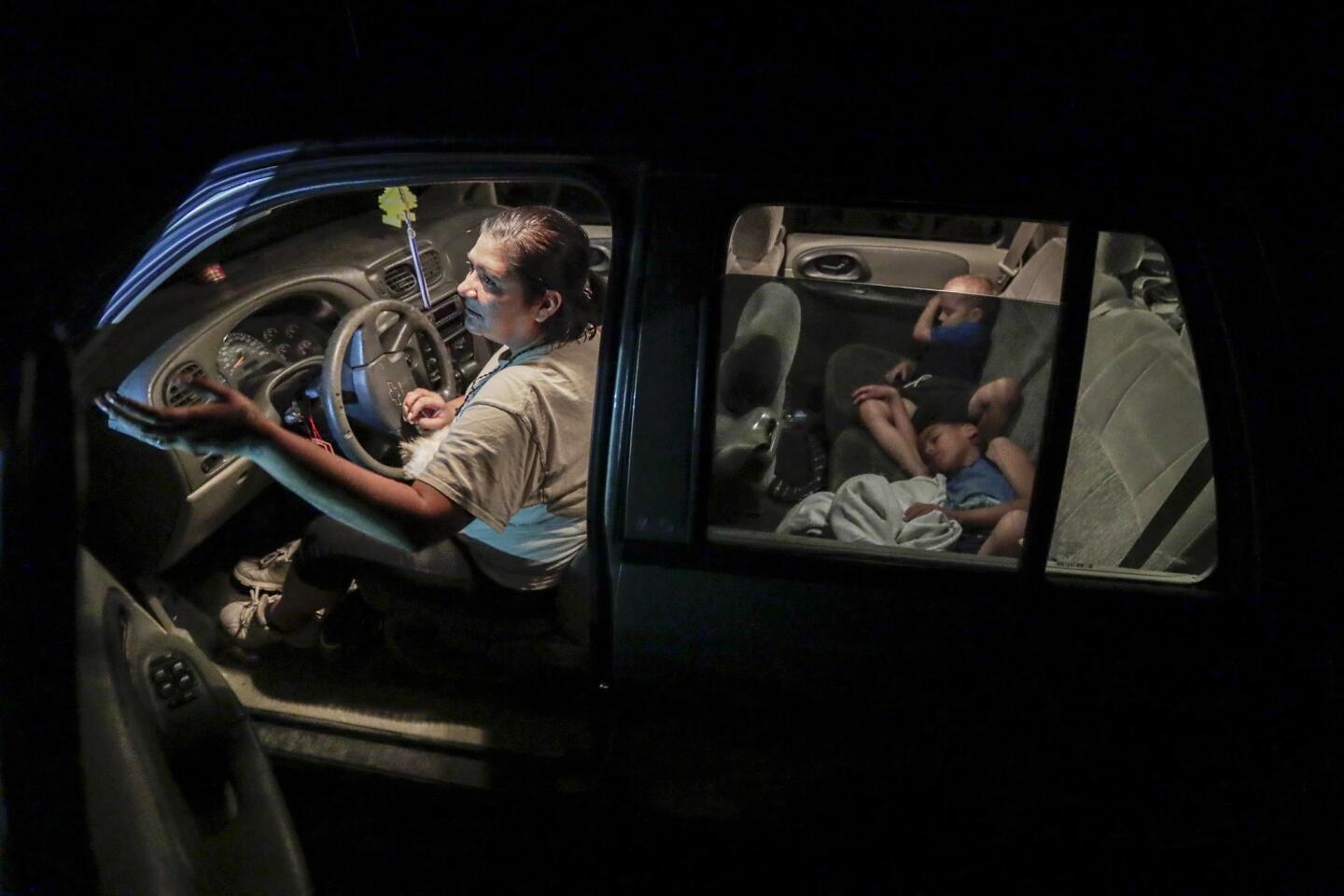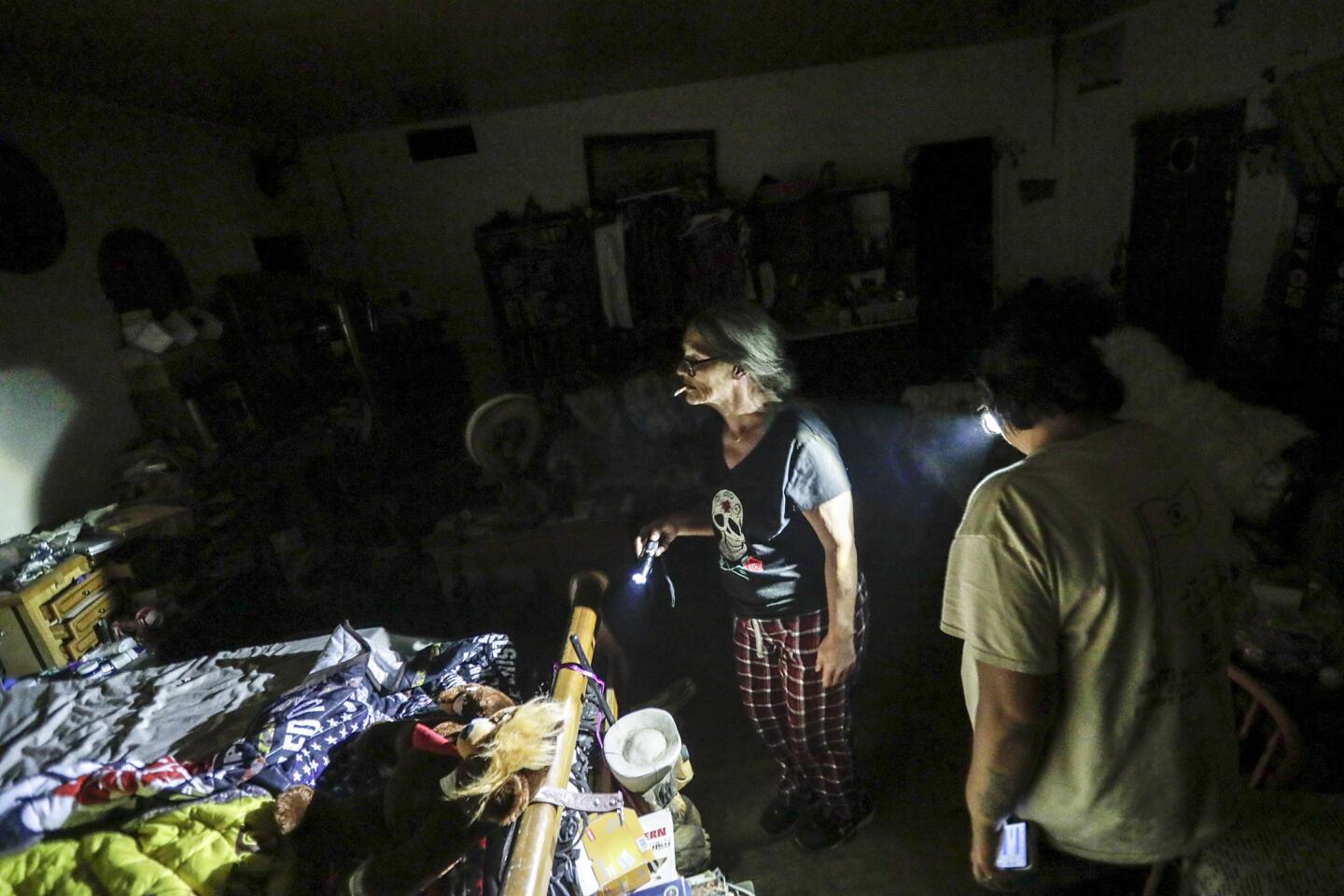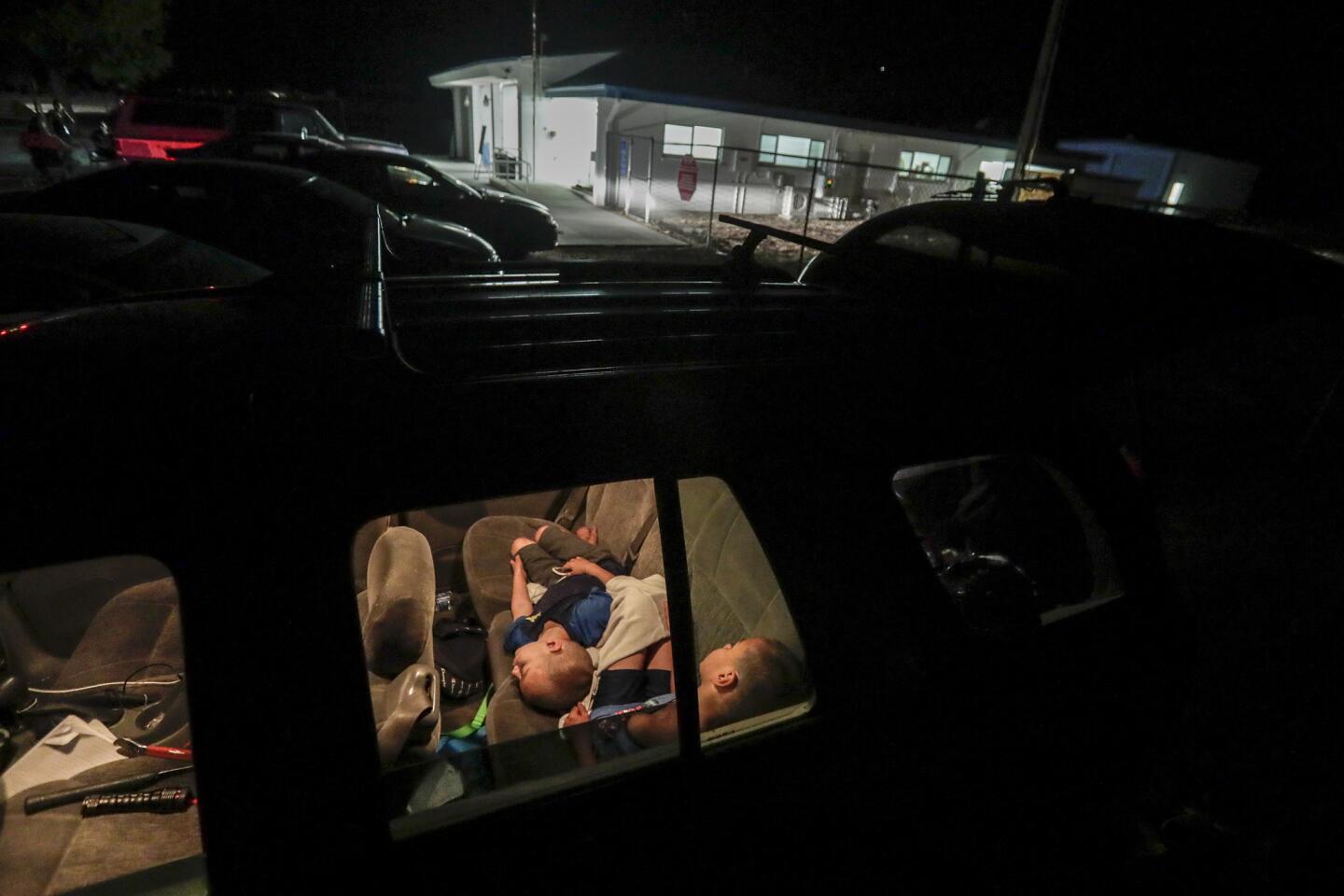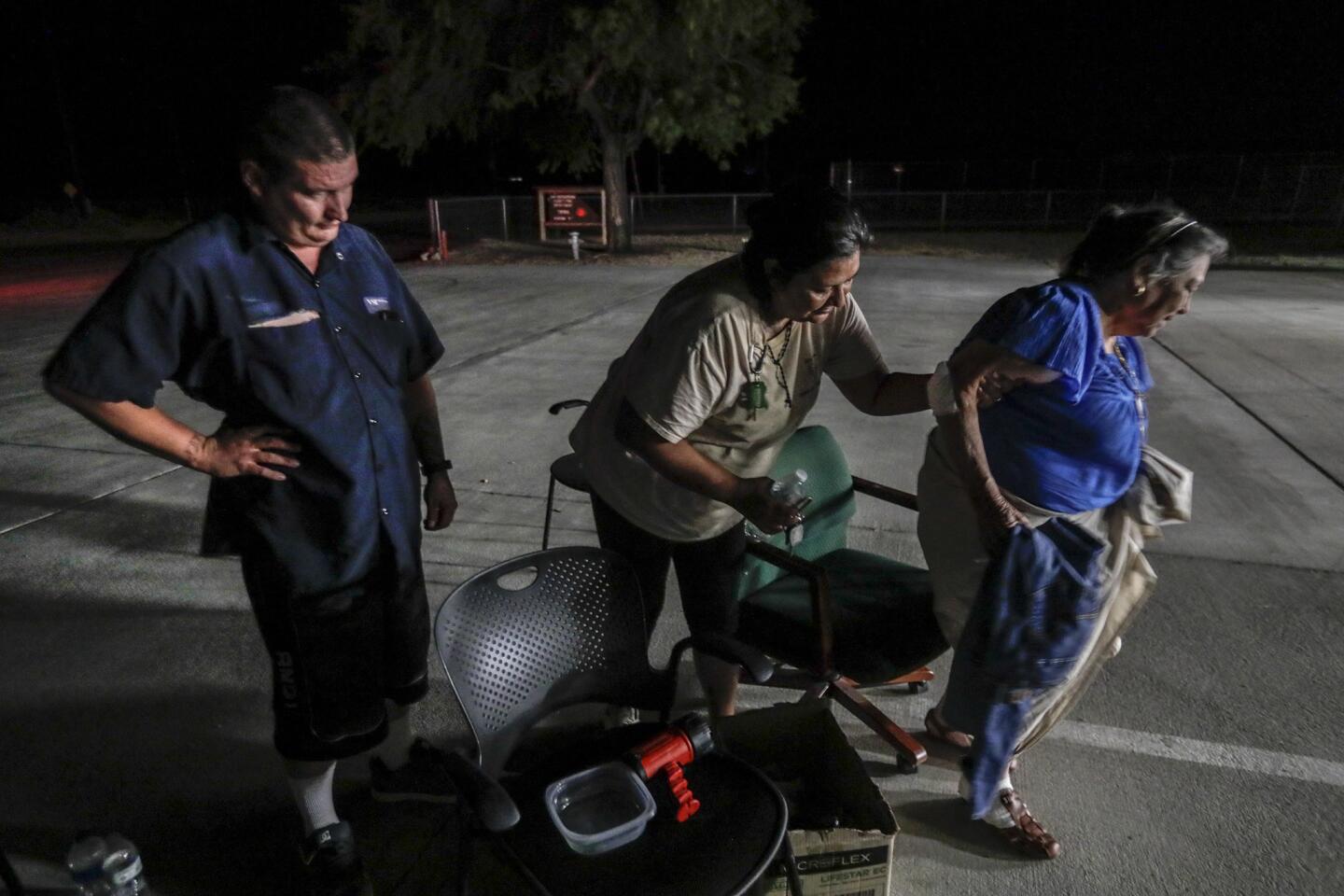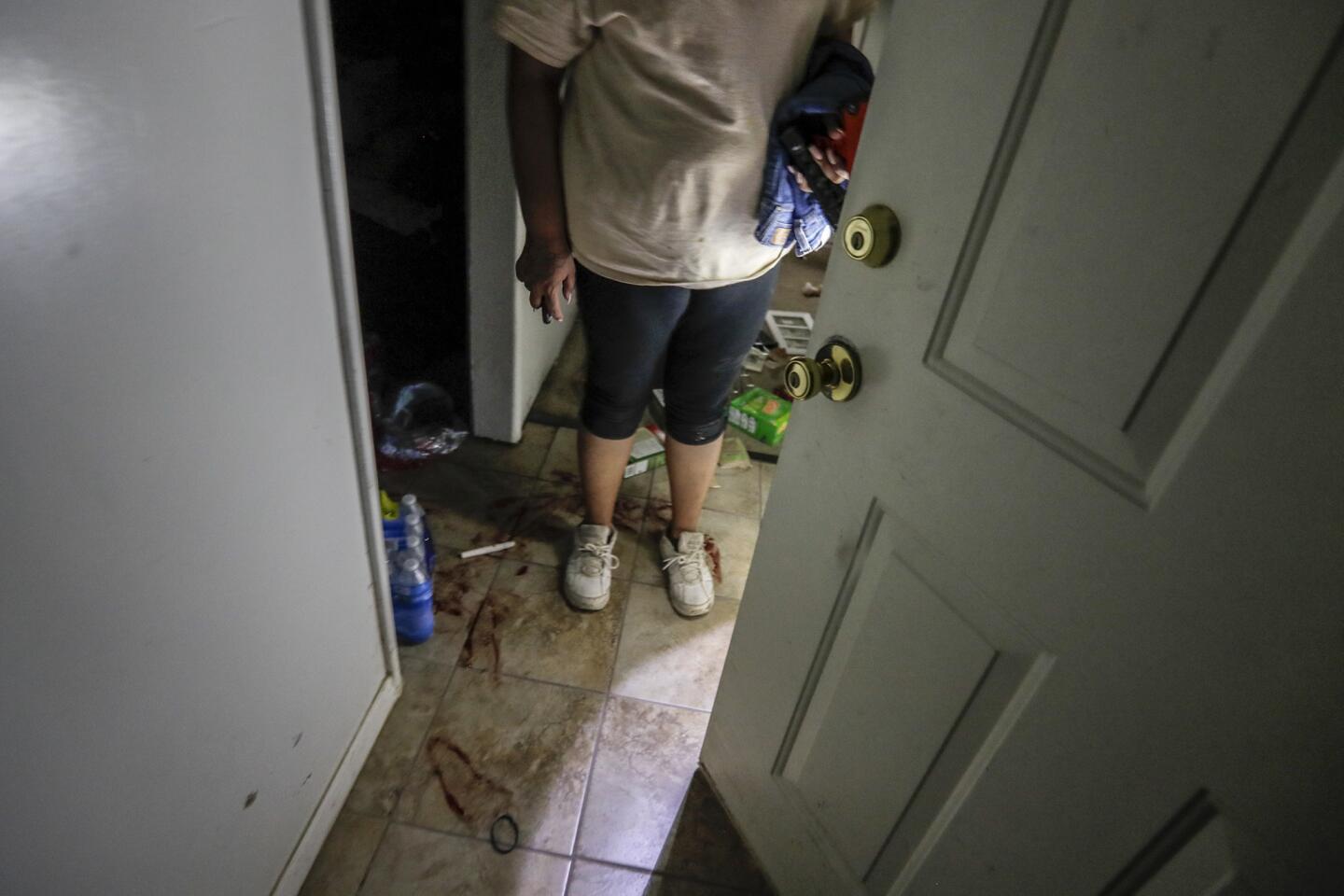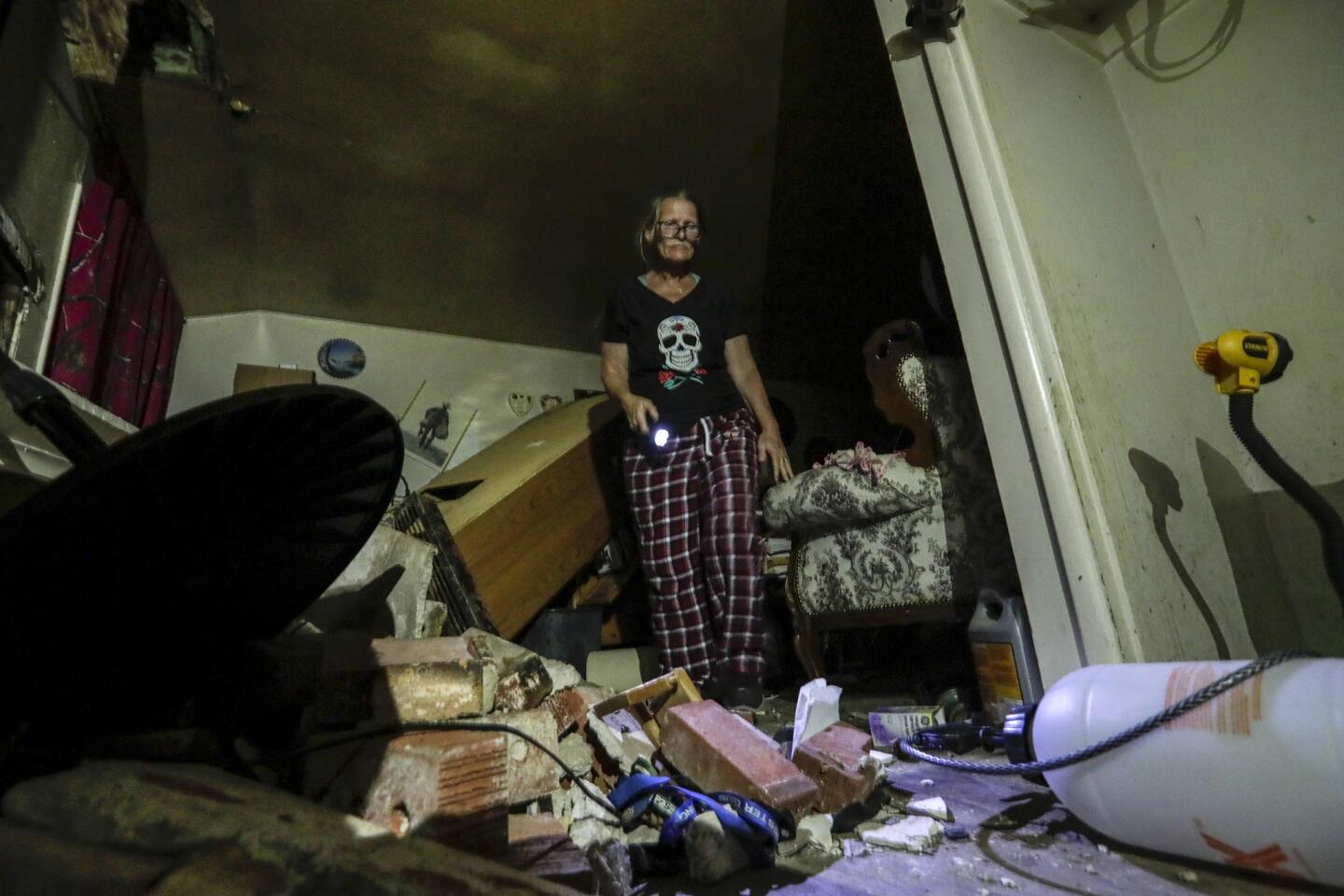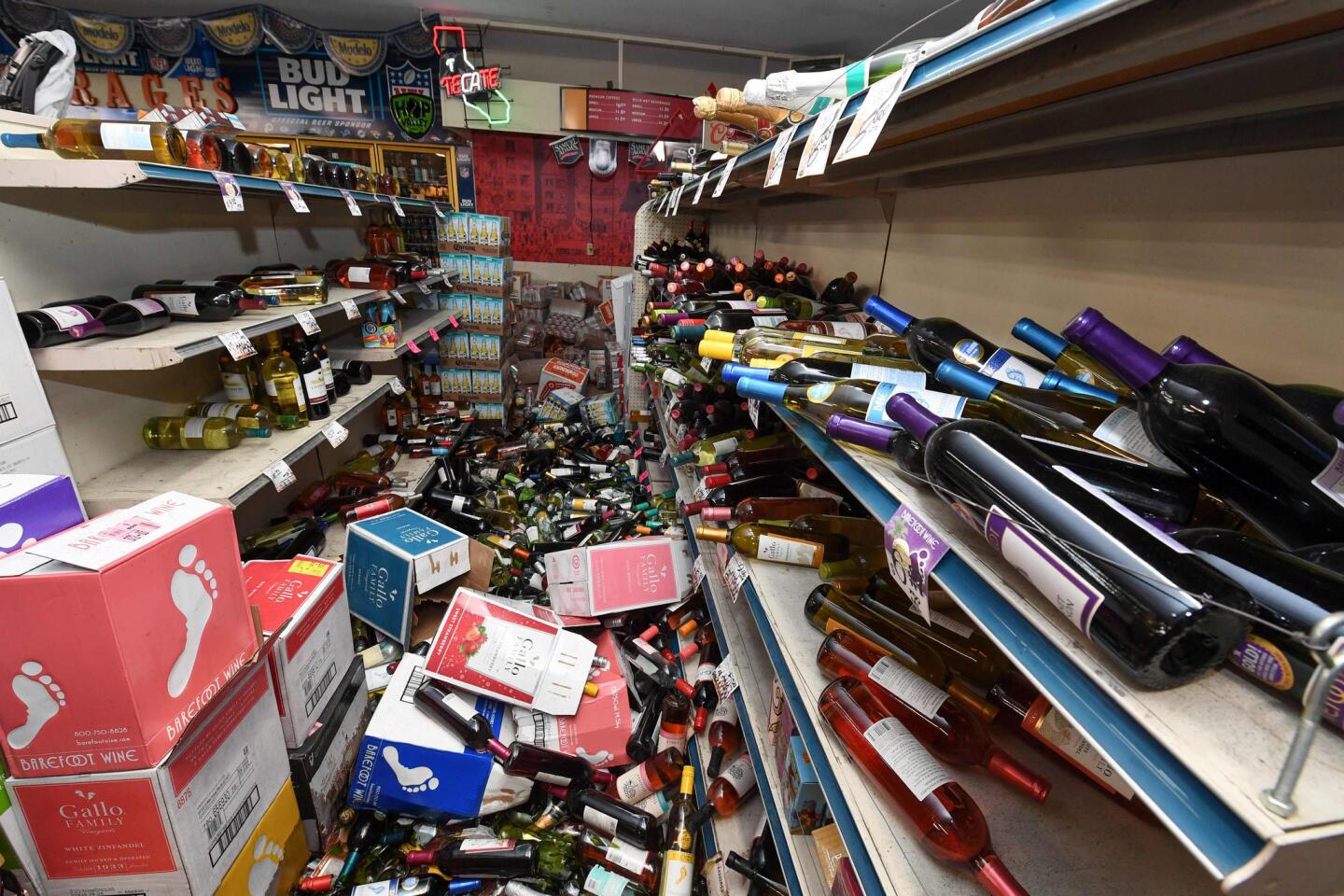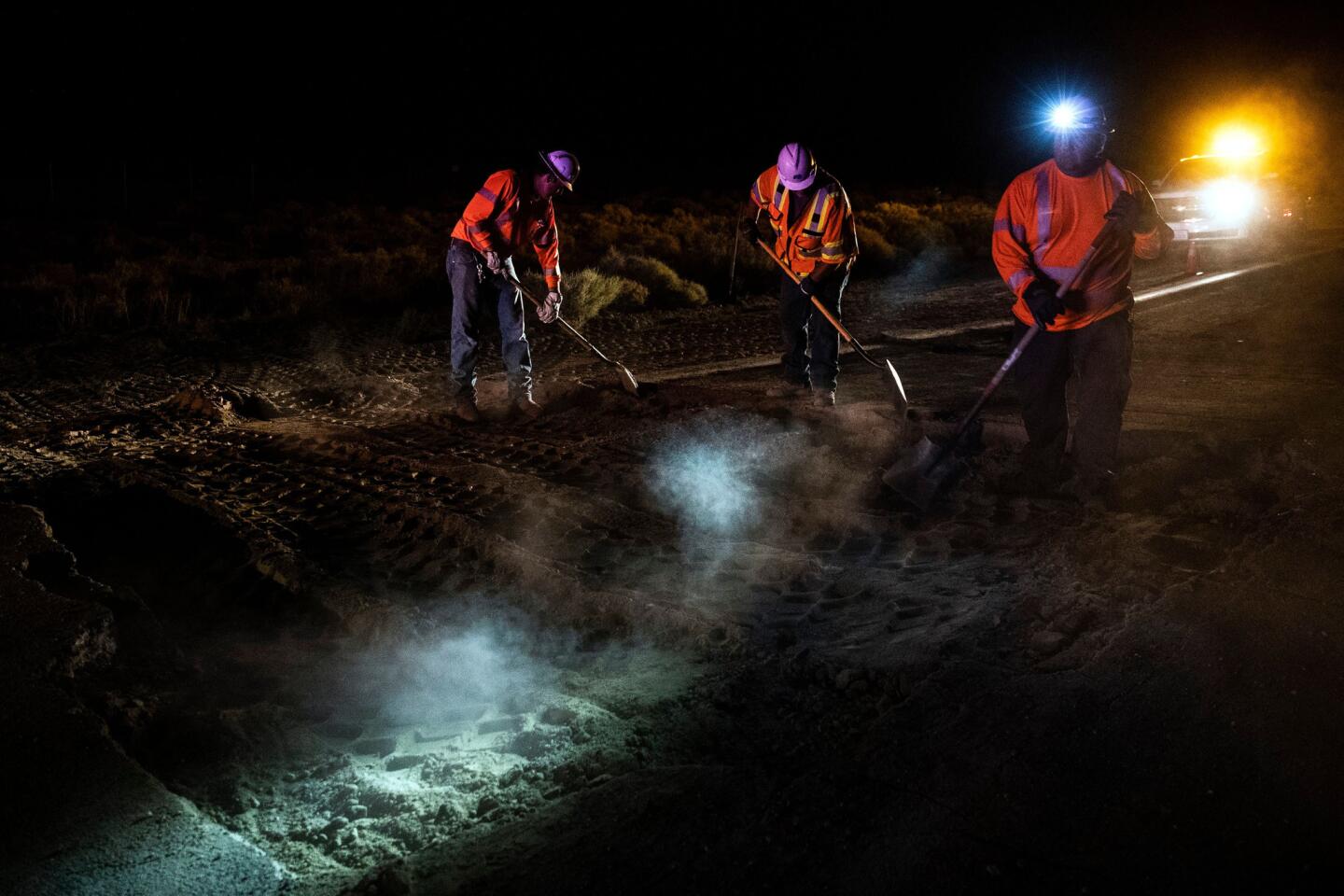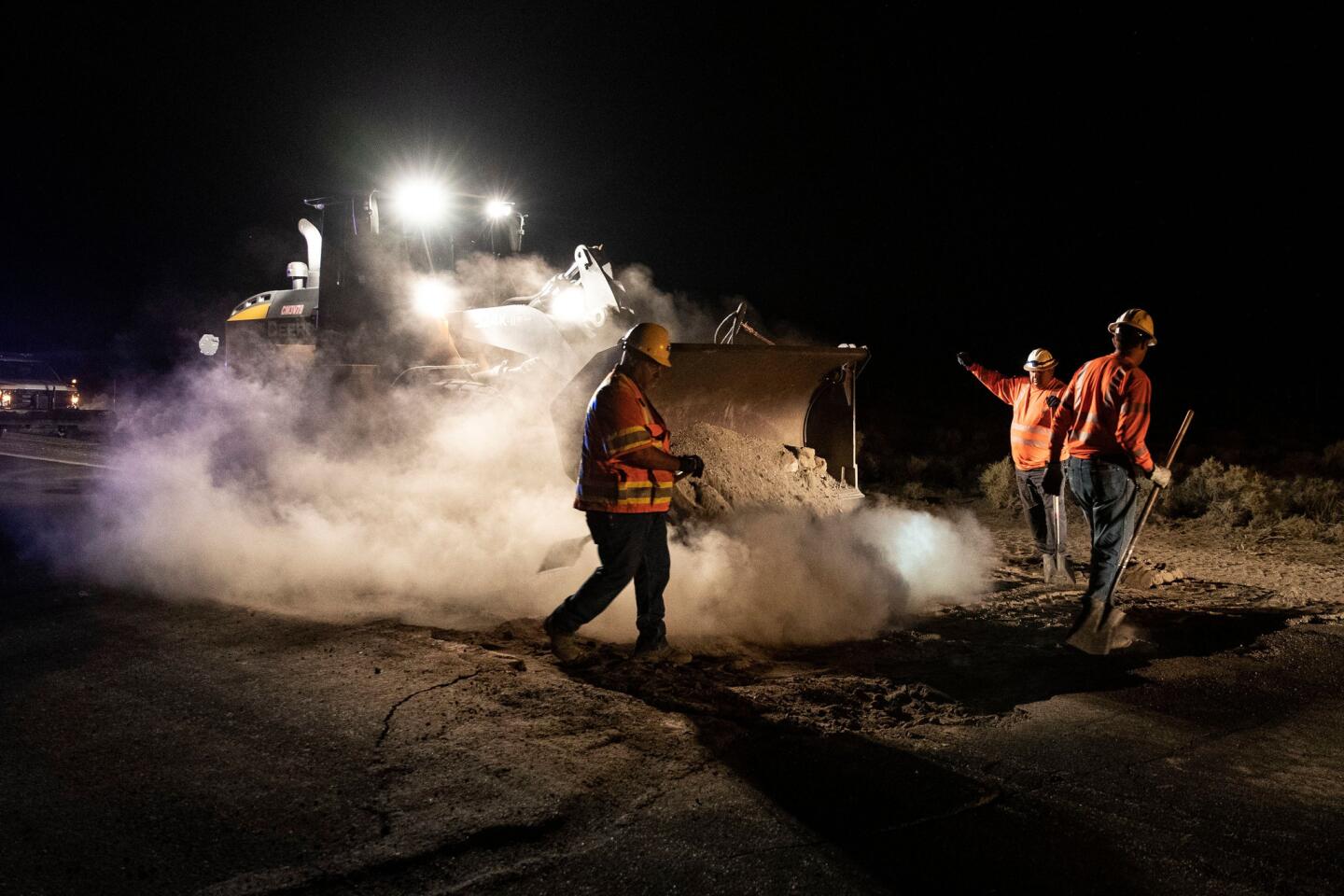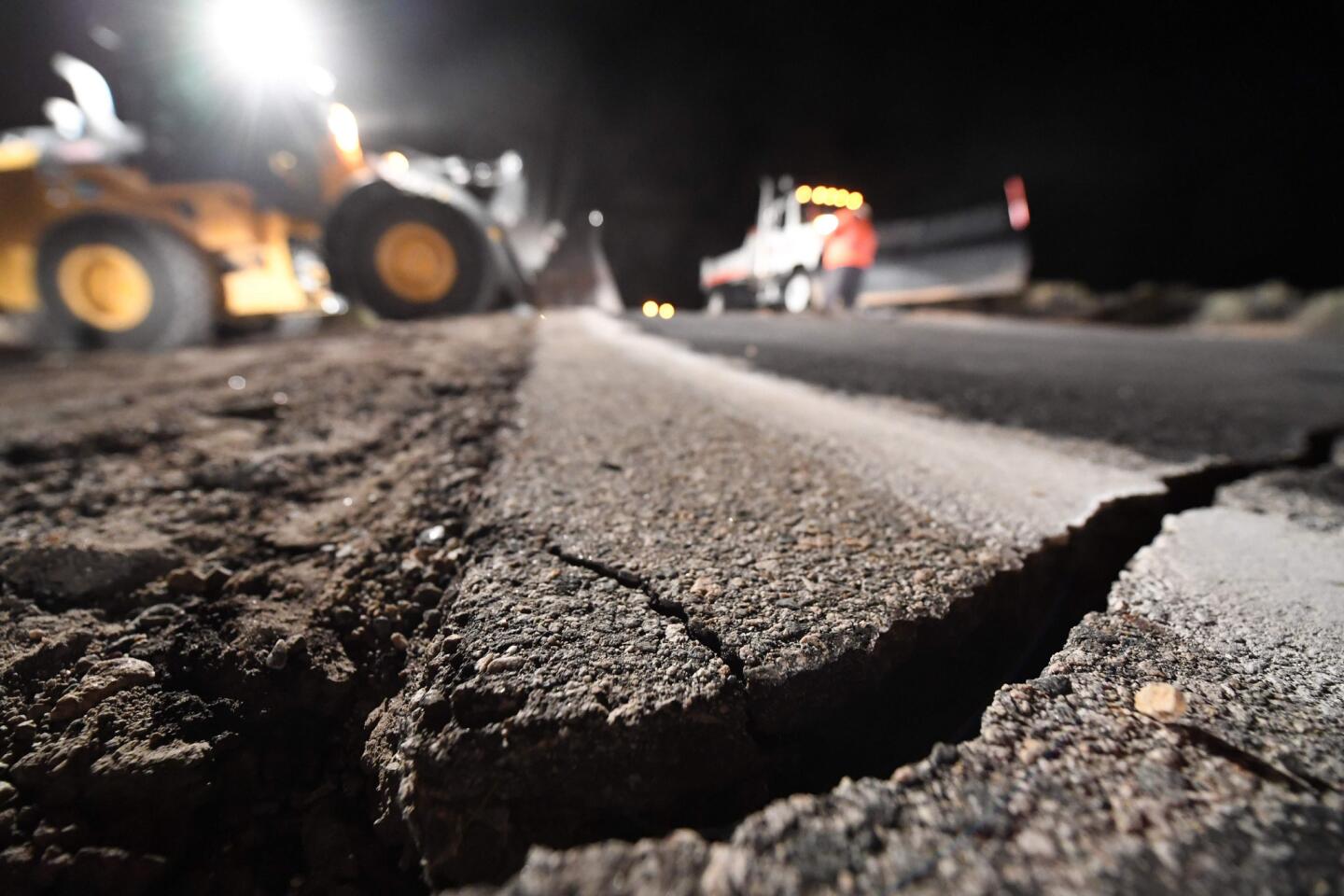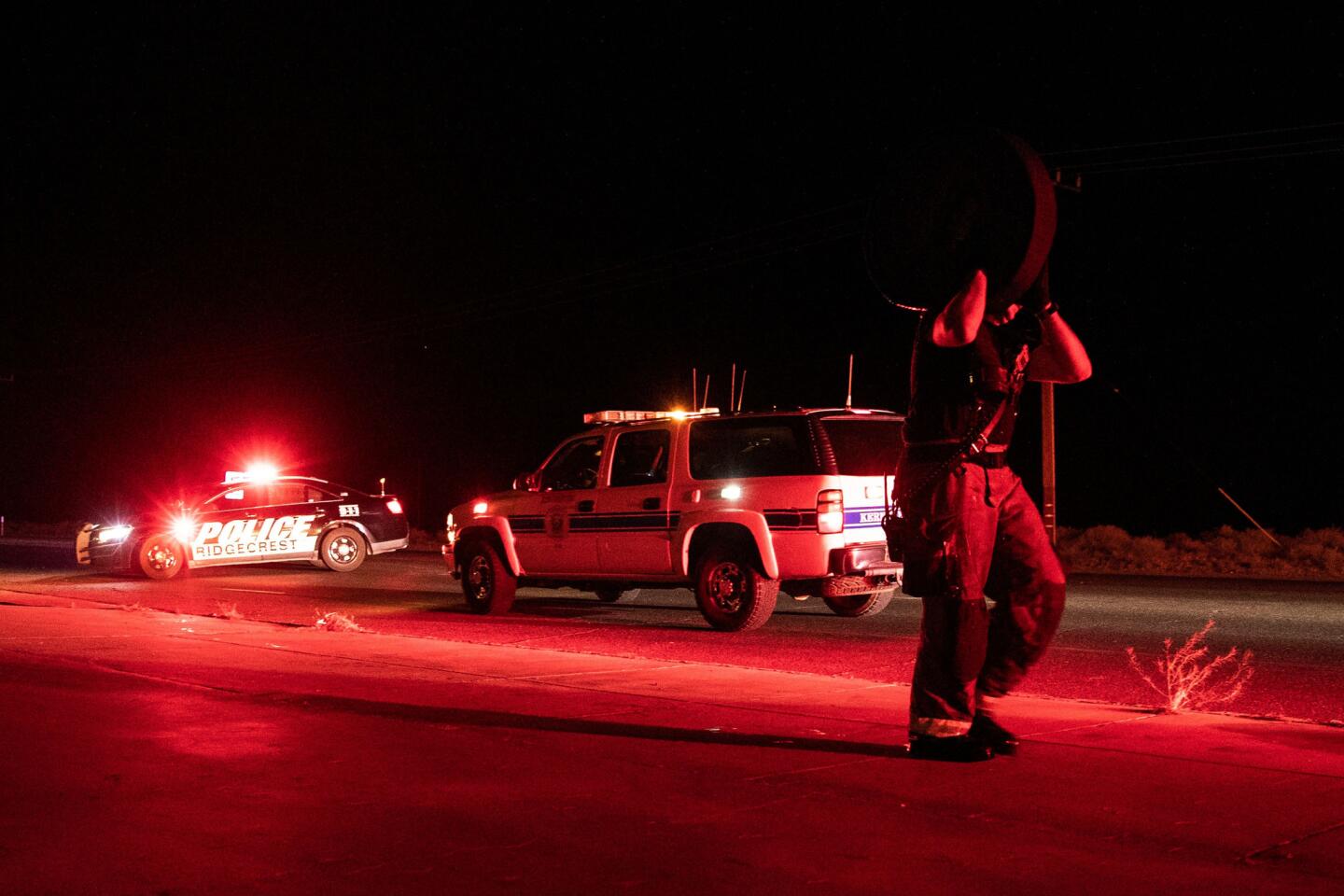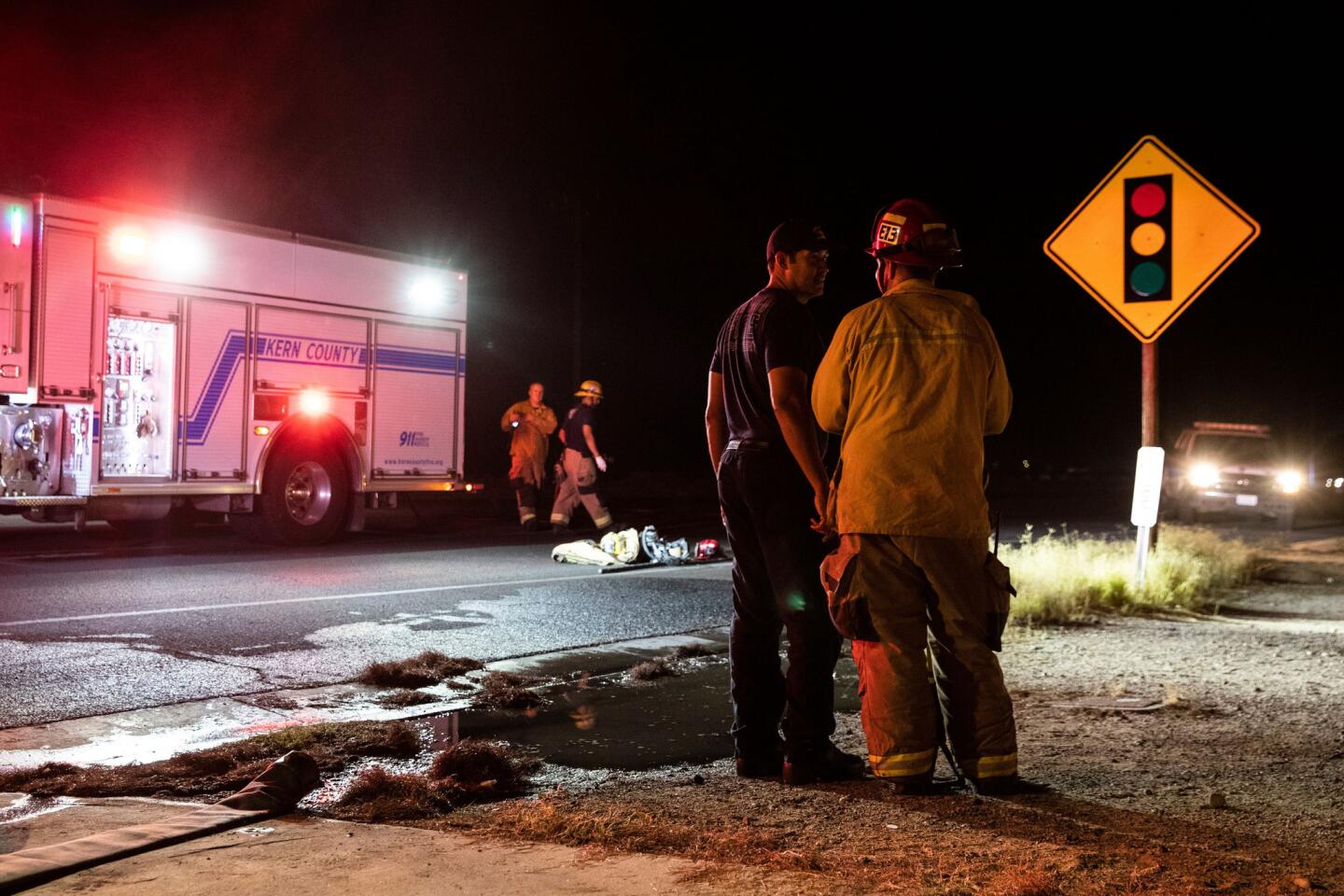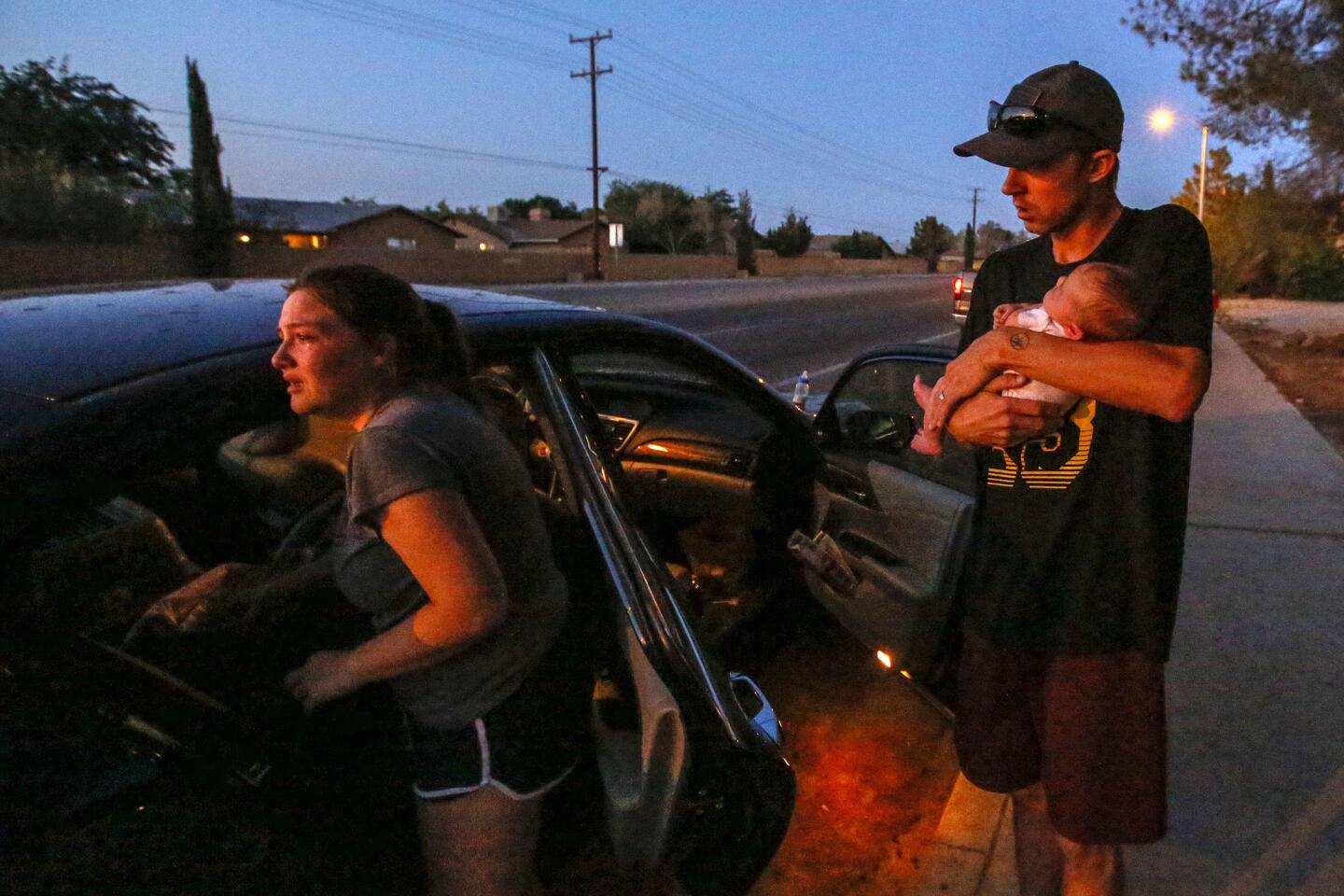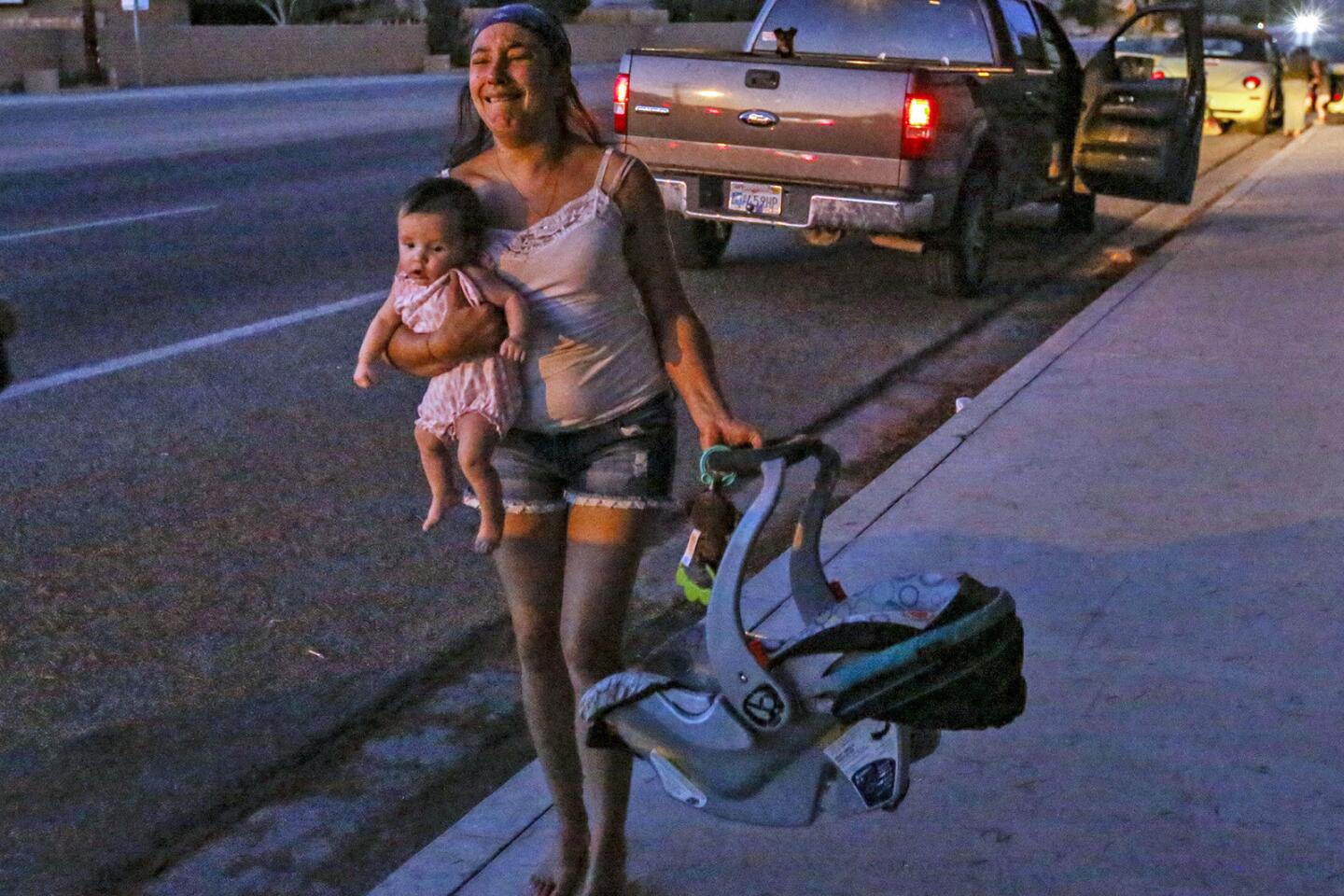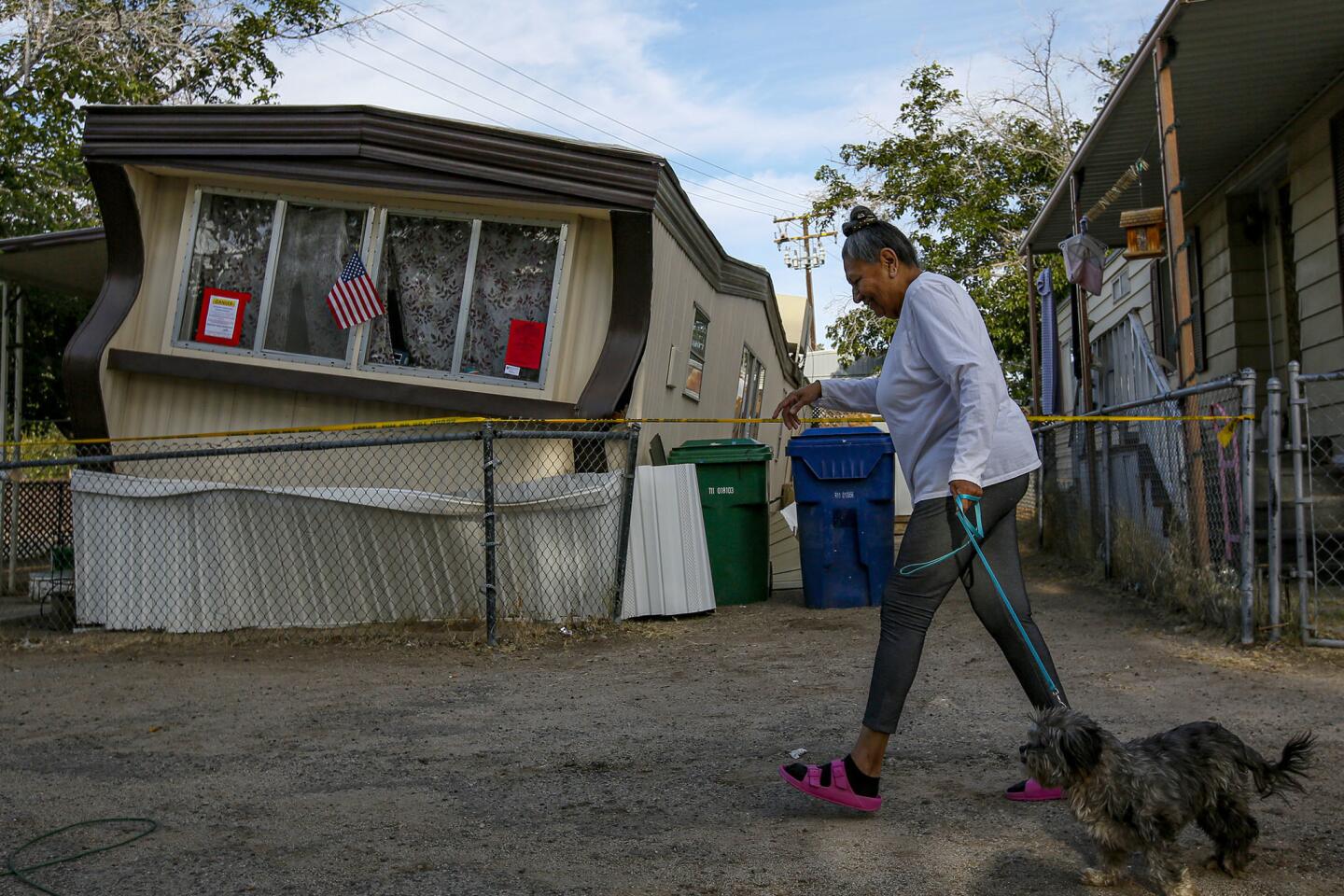The seismic one-two combo that hit Southern California last week left residents particularly unnerved because it robbed them of the single bit of solace that normally comes with a big quake: the sense that the worst is over.
After the 6.4 magnitude quake hit near Ridgecrest on Thursday, many expected aftershocks that would gradually decrease in strength and frequency. Theyâd been through it before, in Northridge, Sylmar and Whittier. But when a much larger 7.1 magnitude temblor struck Friday night, the shock quickly gave way to a newfound dread: Whatâs next?
Caltech seismologist Lucy Jones announced an 8% to 9% chance of an even bigger rupture coming within hours and days. Psyches spun out from Las Vegas to Long Beach, even as the risk was reduced to 3% by Saturday afternoon. The good news: Many decided it was finally time to get prepared.
Full coverage: 2nd major quake in two days hits Southern California Âť
âItâs only a matter of time,â said Kim Caldwell, 55, who has lived in Southern California all her life and experienced numerous quakes. She said she and her husband has been lax about keeping their earthquake supplies stocked and up to date at their home in Santa Ana. But if the first temblor didnât jolt her into action, the second one certainly did.
âIâve grown up with these,â she said. âThis is the first one that was a sizable earthquake where the second one was actually bigger. Normally they trail off.â
Perhaps after a long earthquake drought residents needed the double warning.
Seismologists are constantly fighting against earthquake amnesia, trying to get people â many who have never experienced a major quake, with the last devastating one occurring a quarter-century ago in Northridge â to grasp the severity and ultimate inevitability of the threat and get prepared.
Fridayâs quake was the largest in Southern California since 1999. Although it hit the Ridgecrest area of the high desert hard, it didnât cause any notable damage in the Los Angeles area.
So while the seismic movements over the last few days were unsettling, only time will tell whether it will be enough of a push.
Itâs one of the paradoxes of living in earthquake country that so many remain in denial despite the repeated warnings of the tectonic forces eternally poised to level the region.
Quake preparations can range from simple things â such as having earthquake kits and emergency plans ready â to more expensive items such as backup generators and quake insurance, and retrofitting buildings to better withstand shaking.
Less than 12% of California residents have insurance policies with quake coverage, according to state Department of Finance records.
Los Angeles, San Francisco and some other cities around California have required property owners to reinforce certain types of apartments that are vulnerable to collapse in a quake. L.A. has also required strengthening of brittle concrete buildings.
But experts say many seismic safety gaps remain, from bolting homes to foundations to dealing with chimneys that can collapse during heavy shaking.
If nothing else, the shaking of the last few days has many thinking about these issues.
â[I was] kind of a little shocked that there were two relatively large ones so close together and definitely started thinking about getting an emergency kit together,â said Ivan Castro, of Koreatown.
He was at a Dodgers game Friday, sitting in the top deck two rows from the rim of the stadium, when the earthquake hit. The crowd felt the rolling and then a jolt. âItâs pretty scary, if Iâm being honest,â Castro said.
As a structural engineer, Castro, 31, is accustomed to reassuring his friends that theyâll probably be safe during an earthquake. He knows many structures are built or retrofitted to withstand such movement. But for the next week or so, heâll be avoiding the potential death traps â unreinforced brick buildings.
âIâm even kind of hesitant to take elevators now,â he said.
1/41
Dan Tolbert, 62, spends time with his dogs as he and his wife, Ronnie, 60, prepare to bed down for the night on a pair of mattresses in front of their earthquake-damaged home in Trona on July 10. Their night was interrupted when a scorpion crawled on their mattresses and they ended up spending the night in their truck. âIf we keep feeling tremors tomorrow weâll be out here again,â Ronnie said.
(Genaro Molina / Los Angeles Times) 2/41
Karen Byrd, 39, collects photo frames knocked off the wall at her home in Trona, Calif.
(Irfan Khan / Los Angeles Times) 3/41
Ronnie Tolbert, left, delivers food to Robert VanHorn, 81, almost a week after a 7.1 earthquake near Trona.
(Genaro Molina / Los Angeles Times) 4/41
Benny Eldridge, 76, looks at a quake-damaged room in his Trona home, which he helped build with his father-in-law in 1961. The house has been red-tagged.
(Genaro Molina / Los Angeles Times) 5/41
Benny Eldridge, 76, and his wife, Anna Sue, 75, sit in front of their damaged home in Trona.
(Genaro Molina / Los Angeles Times) 6/41
Joyce Harrison Moore, 72, looks out from her damaged home almost a week after a pair of earthquakes battered Trona. âThis town will either die or get back on its feet,â Moore said.
(Genaro Molina / Los Angeles Times) 7/41
Ronnie Tolbert stands beside her damaged fireplace.
(Genaro Molina / Los Angeles Times) 8/41
Valerie Helton, 60, facing the camera, receives a hug of support from Ronnie Tolbert. Helton and her daughter Jessica Sizemore Helton, left, have refused to leave their home since last weekâs quakes. âThis is all I have,â said Sizemore Helton.
(Genaro Molina / Los Angeles Times) 9/41
Ralph âZebâ Haleman, 67, carries cases of water home Sunday in Trona, Calif., where residents were still without water and electricity was spotty after last weekâs quakes.
(Irfan Khan / Los Angeles Times) 10/41
Kay Byrd, 64, gives herself an insulin shot. Byrd and her family are camping outside in Trona, Calif., wary of returning home after major earthquakes.
(Irfan Khan / Los Angeles Times) 11/41
Brooke Thompson, 8, plays on the sleeping bag that her family slept in after a pair of major earthquakes drove them out of their home in Trona, Calif.
(Irfan Khan / Los Angeles Times) 12/41
The Byrd family has breakfast next to where they spent the night under a salt cedar tree, afraid to return to their Trona, Calif., home of 21 years after major earthquakes.
(Irfan Khan / Los Angeles Times) 13/41
Ronnie Tolbert, left, and her husband, Danny, sleep on mattresses in the front yard of their Trona home, which was damaged in a 7.1 magnitude earthquake.
(Robert Gauthier / Los Angeles Times) 14/41
The Horta family sleeps in the back of their pickup truck in a fire station parking lot in Trona as the sun rises hours after being forced from their home by a magnitude 7.1 earthquake.
(Robert Gauthier / Los Angeles Times) 15/41
Kathy Vander Housen, 76 hugs her friend Claire Barker, 76, after Barker told her that she had found her two cats. Vander Housenâs mobile home in Trona had been yellow-tagged by county inspectors, but she did not want to leave without the cats, which had been hiding since the earthquake
(Irfan Khan / Los Angeles Times) 16/41
Buckled asphalt courses through a parking lot near Trona Rd. in Argus.
(Robert Gauthier / Los Angeles Times) 17/41
Sammy Chute cuddles Gerard as her family in Trona prepares to evacuate to Ridgecrest, abandoning their home that was knocked off its foundation during a 7.1 earthquake.
(Robert Gauthier / Los Angeles Times) 18/41
Charles Ware, 68, in his Trona front yard the morning after a 7.1 magnitude earthquake severely damaged his home. Ware said he invested all he had into this house two years ago, doesnât have earthquake insurance and is afraid he may not be able to rebuild. He was on the phone with his brother in San Diego when the quake hit. âI got to ride it out with my brother,â he said.
(Robert Gauthier / Los Angeles Times) 19/41
A customer rummages for a six-pack of beer at a damaged Shell food mart in Trona the day after a 7.1 earthquake.
(Robert Gauthier / Los Angeles Times) 20/41
Hundreds of residents of Ridgecrest, Calif., and surrounding communities attend a town hall meeting at Kerr McGee Community Center about the response to recent major earthquakes.
(Irfan Khan / Los Angeles Times) 21/41
Christian Fellowship of Trona congregants pray after holding a quick meeting on how to help other community members.
(Irfan Khan / Los Angeles Times) 22/41
Kern County firemen tackle a fire on Saturday morning at Town and Country Mobile Home Park in Ridgcrest.
(Irfan Khan / Los Angeles Times) 23/41
Jamie L. Acevedo sits outside her damaged Trona home, waiting to evacuate to Ridgecrest the morning after a 7.1 magnitude earthquake knocked her home off its foundation.
(Robert Gauthier / Los Angeles Times) 24/41
Gas station owner Roger Sandoval faces the possibility of having to shut his Trona business after a 7.1 earthquake apparently damaged the supply tanks near the pumps.
(Robert Gauthier / Los Angeles Times) 25/41
Chavela Padilla, left, an emergency response team volunteer, walks with Ronnie Tolbert amid quake-toppled items in Tobertâs Trona home. The damage occurred in a 7.1 temblor hours earlier.
(Robert Gauthier / Los Angeles Times) 26/41
Chavela Padilla, a Trona emergency response team volunteer, enters her car after checking on a neighbor as her two young boys, Joey, 8, right, and Jimmy, 5, sleep in the back seat at close to 3 a.m. The boys were too scared to be home after experiencing a 7.1 earthquake hours earlier.
(Robert Gauthier / Los Angeles Times) 27/41
Chavela Padilla, right, an emergency response team member walks with Ronnie Tolbert amid quake-toppled items in Tolbertâs Trona home.
(Robert Gauthier / Los Angeles Times) 28/41
Brothers Joey, 8, right, and Jimmy Raya, 5, sleep in the back seat of their motherâs car in the parking lot of San Bernardino County Fire Station 57 in Trona after their home was damaged in a 7.1 magnitude earthquake hours earlier.
(Robert Gauthier / Los Angeles Times) 29/41
Chavela Padilla, a Trona emergcency response team volunteer, assists her neighbor Alicia Marines, 72, who was injured while trying to escape her home during a 7.1 magnitude earthquake. Marines was evacuated to the local fire station. James Raya, Padillaâs husband and also a volunteer, looks on.
(Robert Gauthier / Los Angeles Times) 30/41
Chavela Padilla, a Trona emergency response team volunteer, stands in the bloody footprints left by homeowner Alicia Marines, 72, who was injured during a 7.1 magnitude earthquake. Padilla volunteered to check on Marinesâ residence and collect some fresh clothes.
(Robert Gauthier / Los Angeles Times) 31/41
Ronnie Tolbert sorts through toppled belongings in her Trona home, damaged in a 7.1 magnitude earthquake hours earlier.
(Robert Gauthier / Los Angeles Times) 32/41
The aftermath of Fridayâs earthquake at a Ridgecrest liquor store.
(Robyn Beck / AFP/Getty Images) 33/41
Work on Route 178 between Trona and Ridgecrest.
(Etienne Laurent / EPA-EFE/REX ) 34/41
Workers fill large holes left in Highway 178 between Trona and Ridgecrest by Friday nightâs 7.1 earthquake.
(Etienne Laurent / EPA-EFE/REX ) 35/41
Highway workers repair roadway near Ridgecrest on Saturday morning.
(Robyn Beck / AFP/Getty Images) 36/41
Police and emergency services respond to a fire at a building on Highway 178.
(Etienne Laurent / EPA-EFE/REX ) 37/41
Firefighters respond to a fire at a building on Highway 178 after Friday nightâs earthquake near Ridgecrest.
(Etienne Laurent / EPA-EFE/REX ) 38/41
In Ridgecrest, Davia Speed and Peyton Speed, holding 1-month-old Lillian, get into their car after Friday nightâs 7.1 earthquake.
(Irfan Khan / Los Angeles Times) 39/41
Dawn Inscore leaves her apartment on Ridgecrest Boulevard with her child after the Friday night earthquake. (Irfan Khan / Los Angeles Times)
40/41
Carmen Rivera, 65, walks her dog Ash past a dislodged home in Torusdale Estates mobile home park in Ridgecrest. (Irfan Khan / Los Angeles Times)
41/41
Zoe Pineda, 7, helps clean up the library in Ridgecrest after the Fourth of July quake. (Irfan Khan / Los Angeles Times)
Seismologists say the fault that ruptured would probably not set off the mighty, slumbering San Andreas, which is overdue for âthe Big Oneâ that every Californian should fear.
âItâs going to happen eventually,â Castro said. âI just got to tell myself be prepared as possible, talk to your friends, to your family; if youâre not at home, where are you going to meet?â
Jones said since officials began measuring earthquakes since 1932, there have been 22 of a magnitude 6 and above. Only two of those â including the one on July 4 â have been a foreshock to a larger one.
The last was in 1987, when a 6.2 magnitude quake struck south of the Salton Sea, followed by a 6.6 magnitude 12 hours later.
âIt was really similar, itâs just that it was 30 years ago and nobody remembers,â said Jones, who has led the battle against earthquake amnesia.
She said roughly one in 20 earthquakes are followed by a bigger one within 30 days.
After Thursdayâs quake, Paola Fernandez, 27, went online to research supply kits and disaster planning, and carried a battery pack to keep her phone charged.
But she didnât think too much more about it, until the even the bigger one struck as she was at a downtown L.A. bar at happy hour. The potential severity of a closer seismic rupture hit home.
âThis morning I was like, I need to start making a plan. I need to figure out what I need to do,â she said Saturday. âI need to prepare for any possibility of not being home or being stuck somewhere ⌠all these worst-case scenarios come to mind.â
âI went to brunch and I was thinking to myself, âif this building started shaking where would I go?ââ Fernandez said. How would she get to safety or connect with her family?
She identified an uncle in Colorado and made sure every family member had his number â in case of a massive earthquake or emergency they would each contact him to let him know they are safe.
Fernandez lives with her sister and father in Mt. Washington, down the street from her grandparents.
âFor me Iâm really concerned about my grandparents and like the older generation what could happen to them. I think thatâs just one of my biggest concerns.â Her plan Saturday was to scour the cityâs ShakeAlertLA app, and resources such as the Red Cross and government websites for preparation tips on what to put in her car and in her homeâs earthquake kit.
Sheâd also go to her grandparentsâ house and make sure their items were secured and not at risk of falling and hurting them.
âI feel like definitely itâs kind of like a wake-up call, itâs the reminder that we live in California and this is something that happens and weâve been kind of waiting for it for decades now â the next Big One. It just feels like the likelihood of it happening is bigger than it was before the Fourth of July.â
âThis is the geology of the land you live on so you just got to be careful.â
Times staff writers Deborah Netburn, Alex Wigglesworth and Karen Kaplan contributed to this report.

